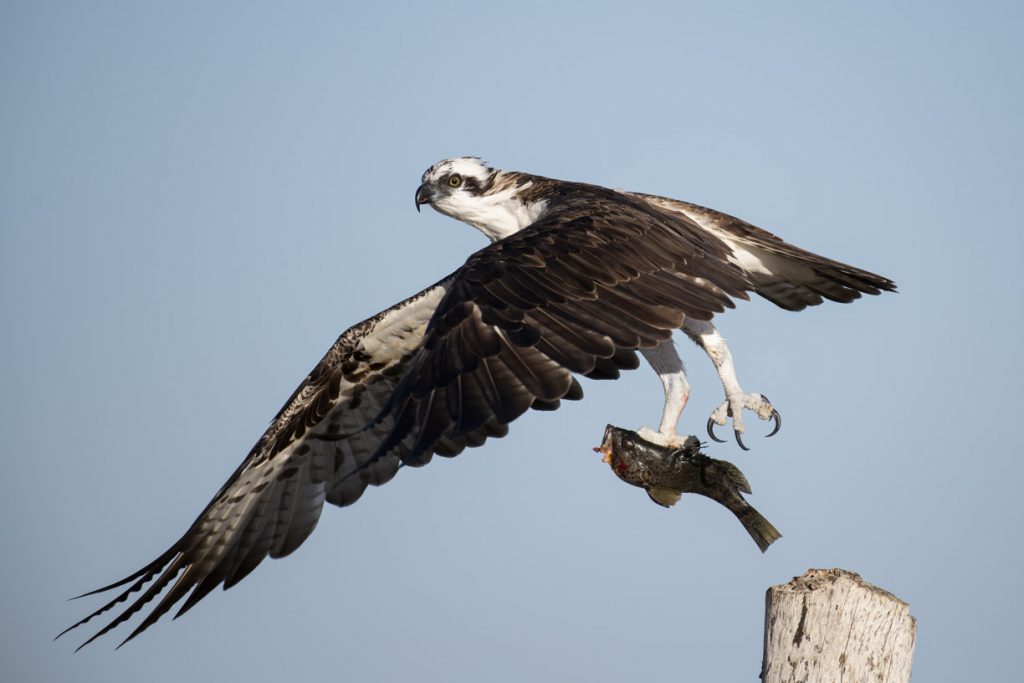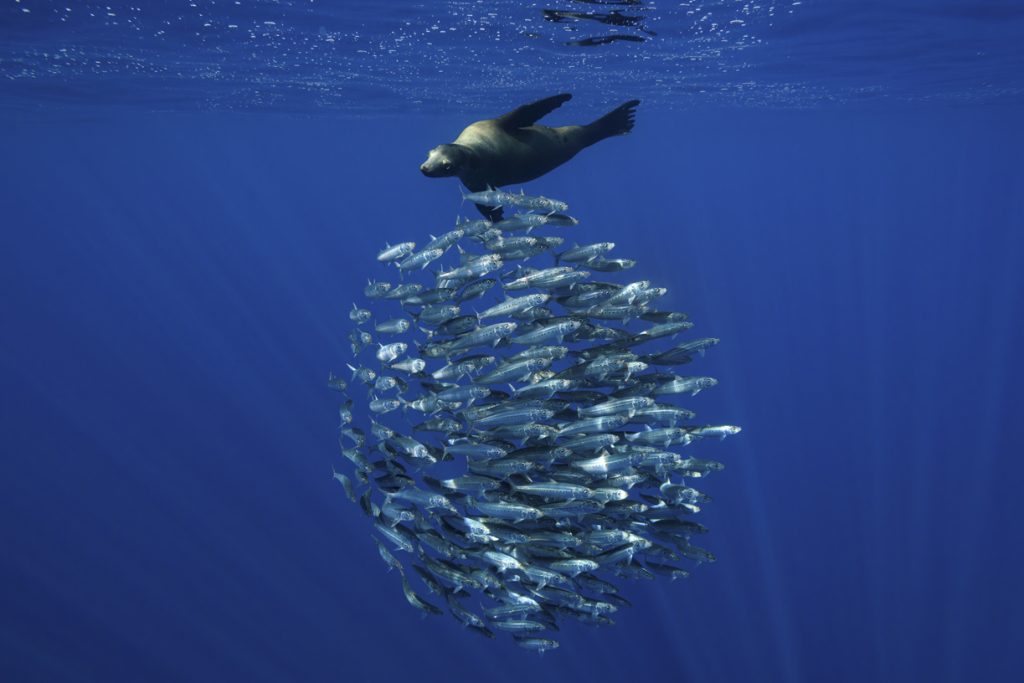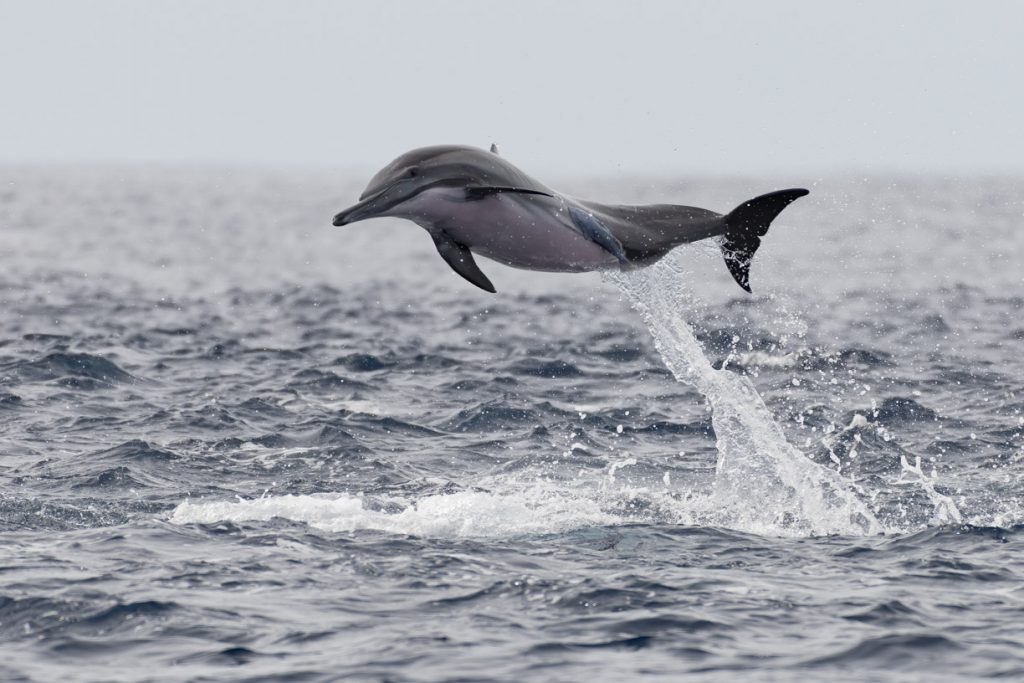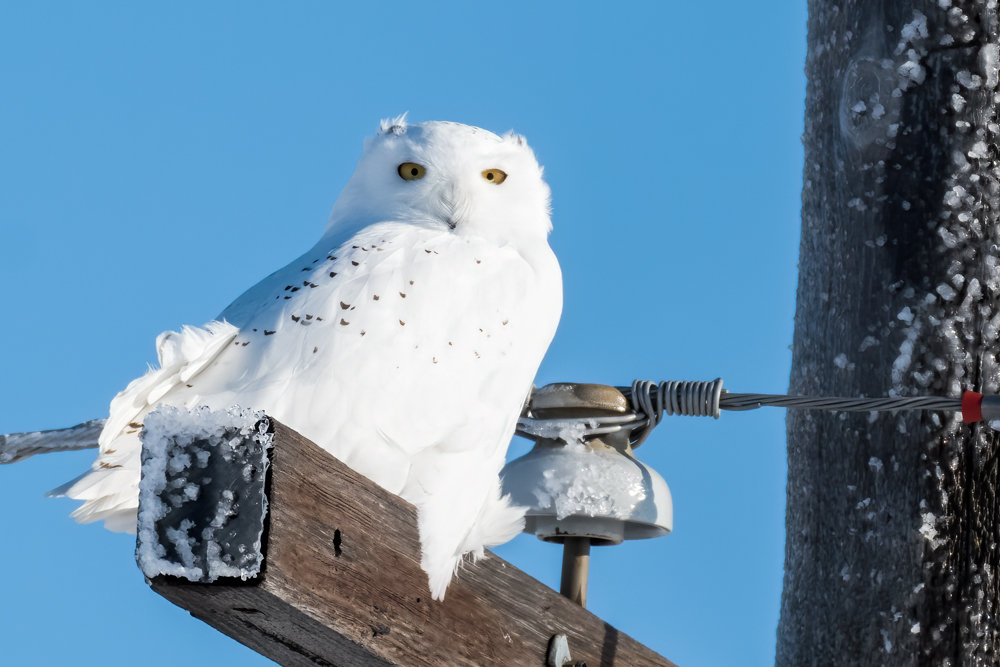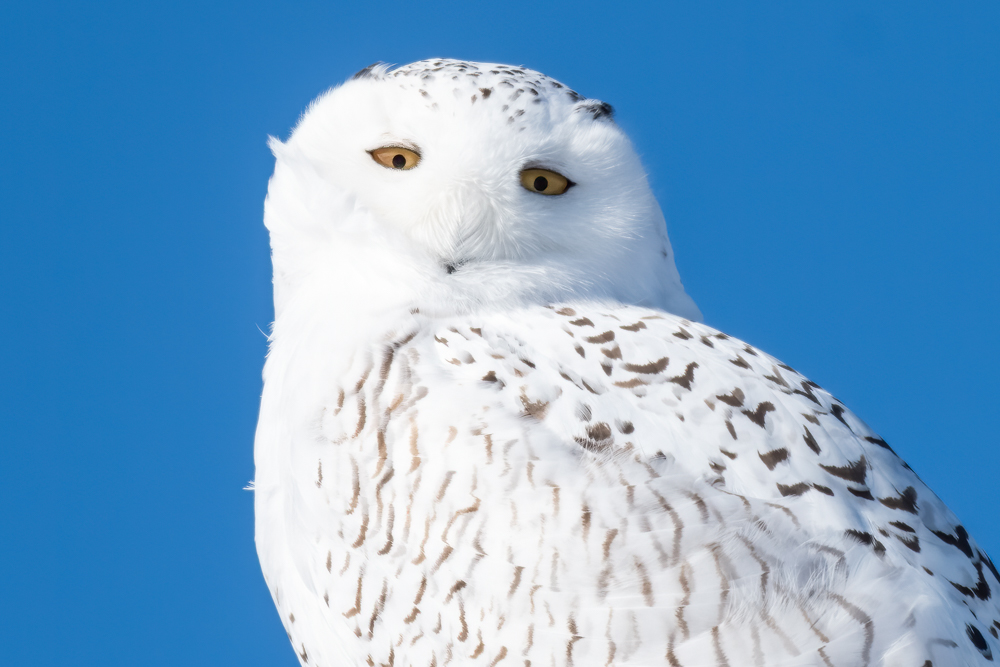One Week in Borneo
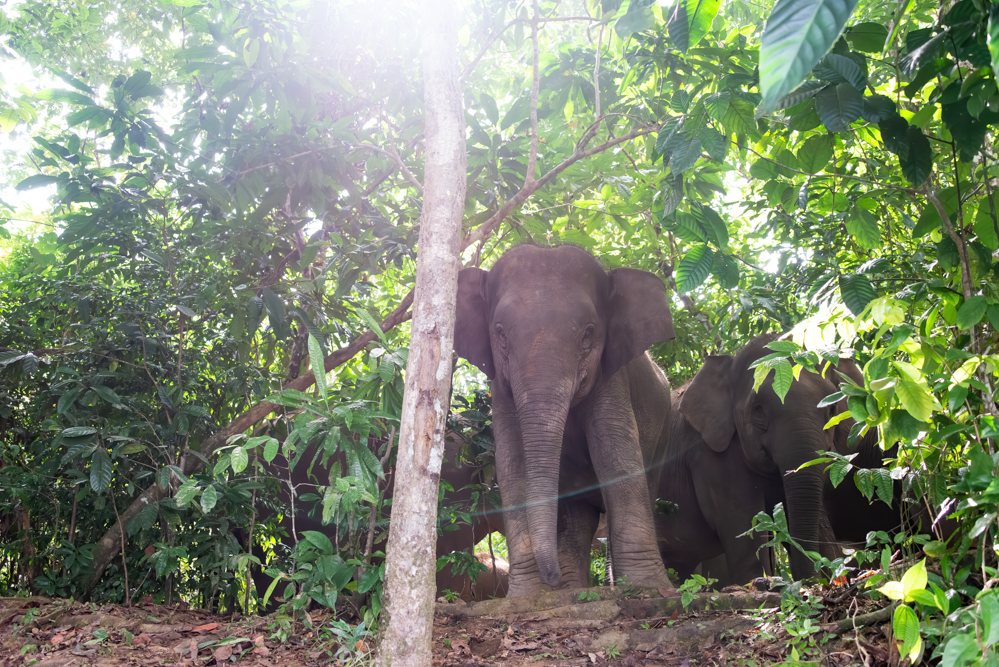
I was quite apprehensive in the weeks and days leading to our departure for Asia, especially after consulting the Canadian Government’s Travel Advice and Advisories webpage. Apparently, the potential for terrorist attacks and kidnappings existed for the East Coast of Sabah. Compile that with the timely appearance of the coronavirus and the awakening of the Taal Volcano (we connected through Manila) and my anxiety was topping the charts. To ease my nervousness, I consulted my family’s travel expert – my wanderlust niece – and she reassured me that her experiences in Malaysia had been nothing short of amazing due in part to the friendliness of the people. That information put me somewhat at ease and since the Covid 19 epidemic was contained to mainland China at the time of our departure and as the Philippine dragon seemed content to simmer, I felt that there existed the possibility that we would have an unbelievable adventure in Borneo. As I reflect on this experience, my words are a futile attempt to describe how truly incredible it was!
The Long Road to Nowhere
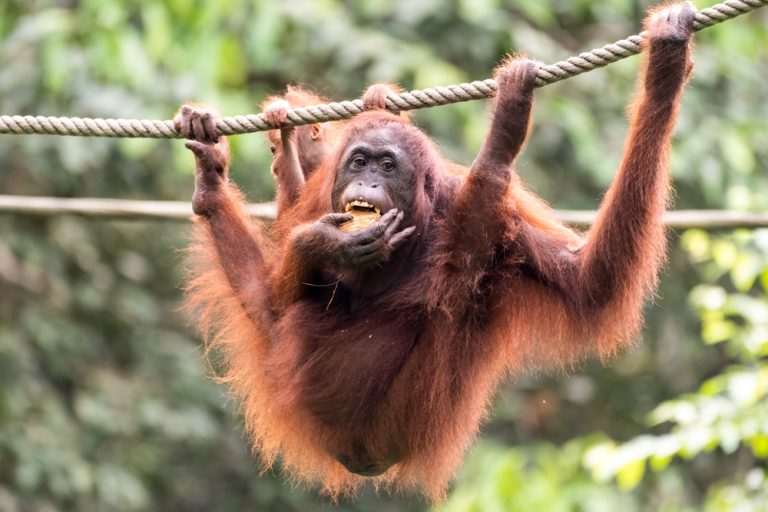
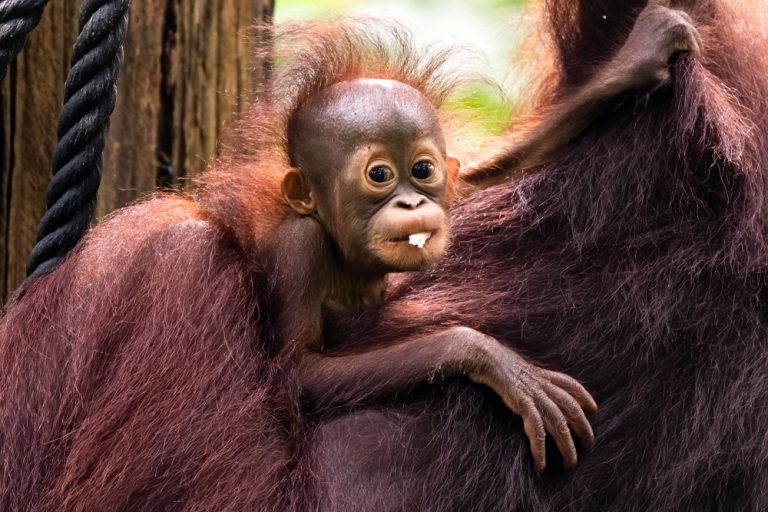
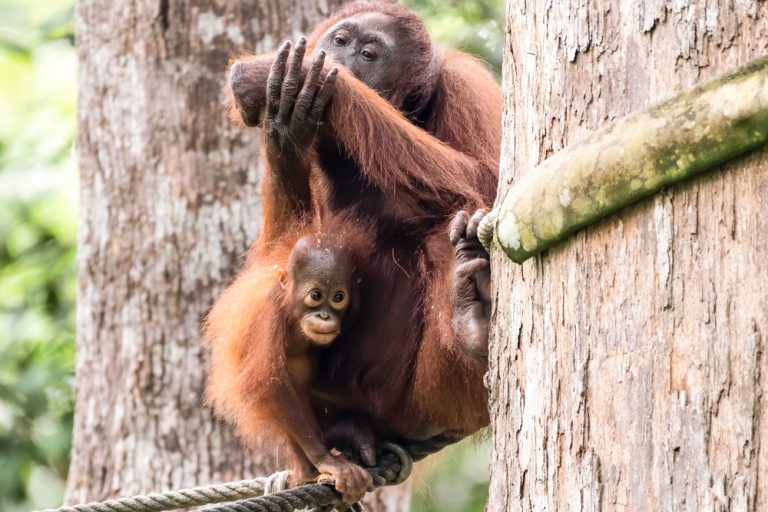
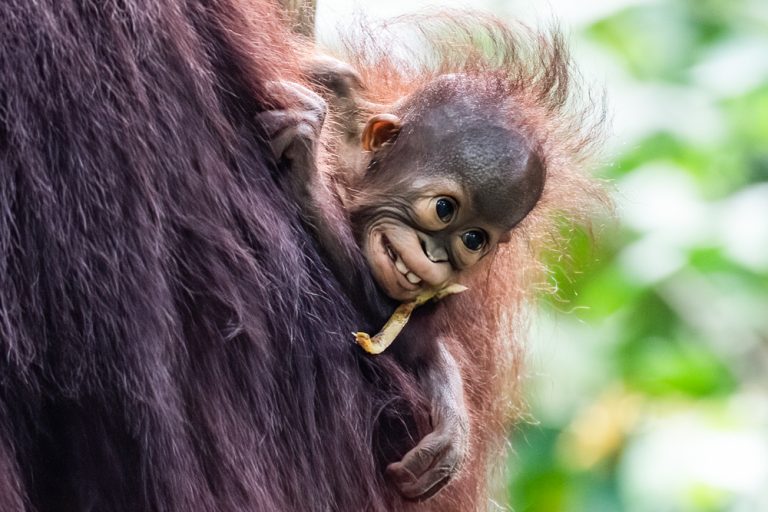
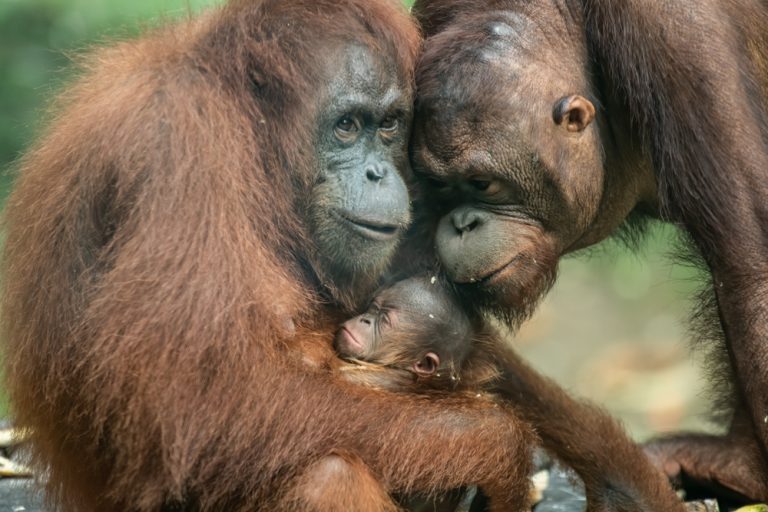
Images from the Sepilok Rehabilitation Center
After a week diving the waters of Malapascua, we began our journey to Sandakan. In order to travel a seemingly short 806 km, we needed to take not one, not two, but three flights totaling 4888 km and a record twenty-two hours including the airport formalities and a mandatory overnight stay in Kuala Lumpur. On February 9, we finally picked our luggage off the last carousel, found our driver, and headed to Nature Lodge Sepilok where our guide Adi awaited us. This twenty-something, as we quickly realized, had a wealth of knowledge and experience concerning her native Borneo, and she was determined to share as much as possible with us. Once we were checked in to the resort, she whisked us off to the Sepilok Rehabilitation Centre. This project, located within the Kabili-Septilok Forest Reserve, rescues orphaned and injured orangutans from logging-sites, plantations, illegal-hunters, and would-be pet owners. Inside one of the buildings, we were able to observe the baby orangutans with their mothers. I was amazed at how gentle these primates were with the very young and the bond between parent and child was visibly strong. After several minutes we moved outdoors to watch the orangutans feed on the meager offerings. The centre feeds the apes twice daily but the mundane food encourages them to forage, preventing them from becoming totally reliant on humans for their survival. Although zoo-like in nature, its fenceless grounds gave us an opportunity to observe the orangutans in an almost natural setting and to hone our photography skills for the days ahead.
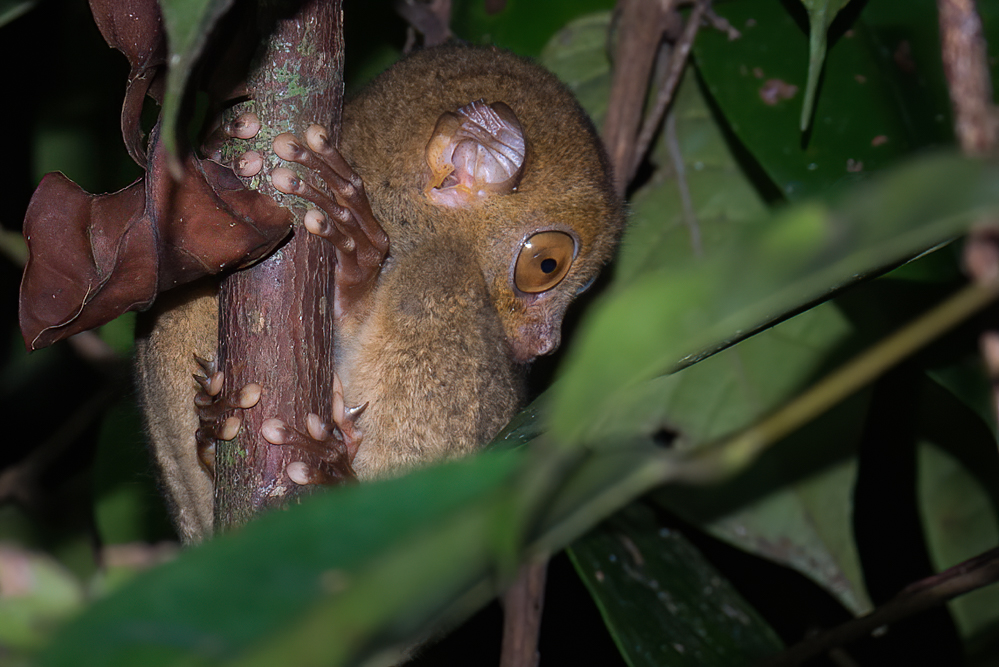
Just before sunset, we began our second excursion, hiking the trails of the reserve in search of nocturnal animals, and were fortunate to spot flying squirrels, a Western tarsier (a rare find), tree frogs, tarantulas, as well as many other critters. I was most pleased about finding a sleeping kingfisher only a few feet off the trail. All in all, day one was a great introduction to Sepilok’s variety of plant and animal life, and for me, a personal acquaintance with the dreaded leech!
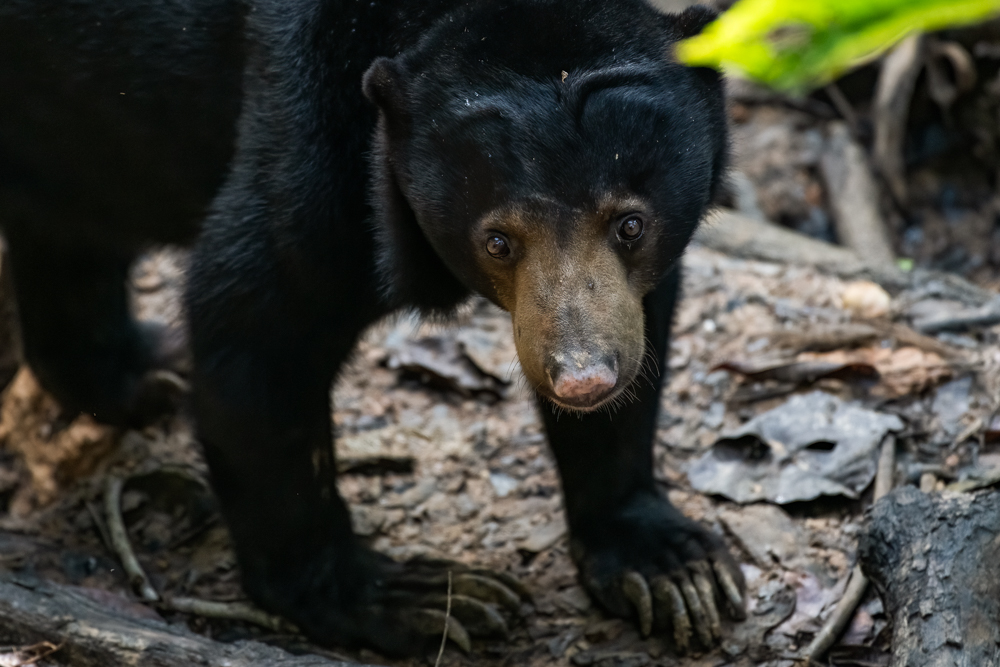
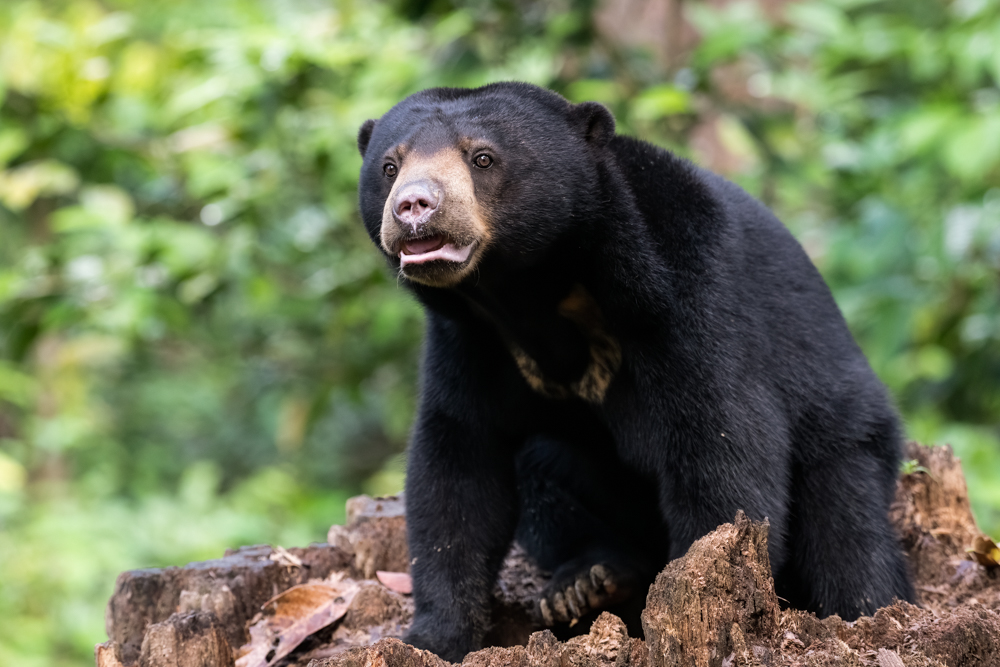
On day two, we toured the Bornean Sun Bear Conservation Centre that focuses on the welfare and rehabilitation of the Malaysian sun bear, and on creating awareness of their plight. We trekked to the various viewing platforms and were entertained by one bear in particular, grooming on a tree stump only a few metres away. As the chance of encountering a sun bear in the wild is quite slim, we were content to snap a few proof-of-life photos, but it was obvious that we were ready for a much more intimate experience, one less hindered by human intervention, and were anxious to begin the six hour drive to Deramakot Forest Reserve.
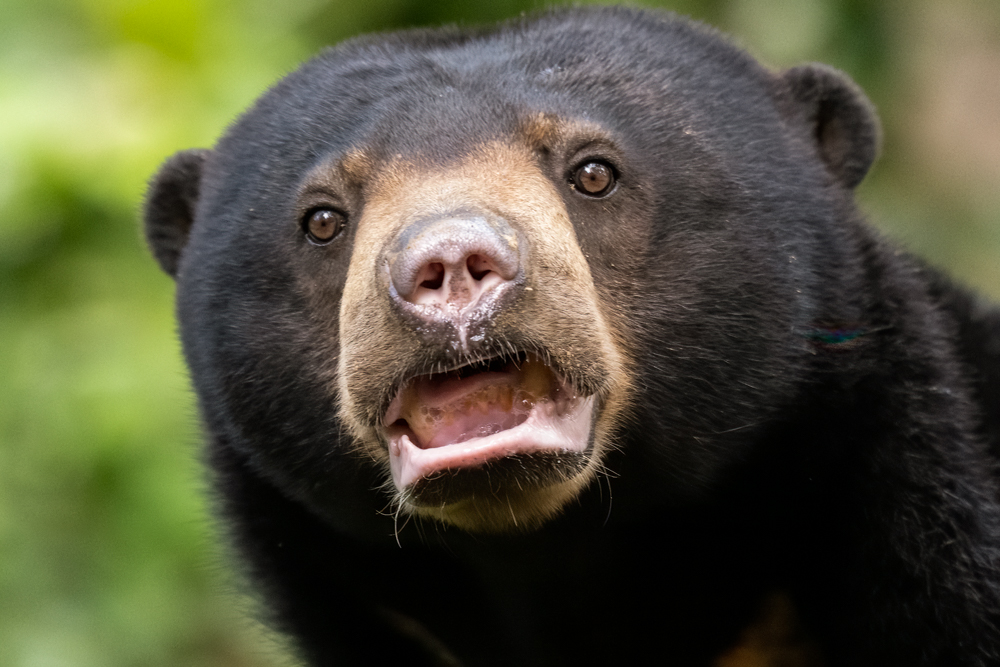
We're Not in Kansas Anymore

After reloading our gear into the van, Eli, JP, Adi, Glenn and I settled in for the long journey. Along the way, we passed numerous palm plantations that littered the horizon and one checkpoint with armed soldiers, and, although they were concentrating more on their phones than our faces, I was slightly nervous at the site of the assault rifles they carried. After stopping for lunch in Telupid at Restoran and Cafe 77, we switched vehicles, boarding two trucks with off-road capabilities. As the kilometres clicked away, we were driven farther and farther from civilization, from highway dotted with open-air stores, to gravel road sandwiched between endless rows of palm, to tree lined dirt and rock trail that led to our isolated destination.
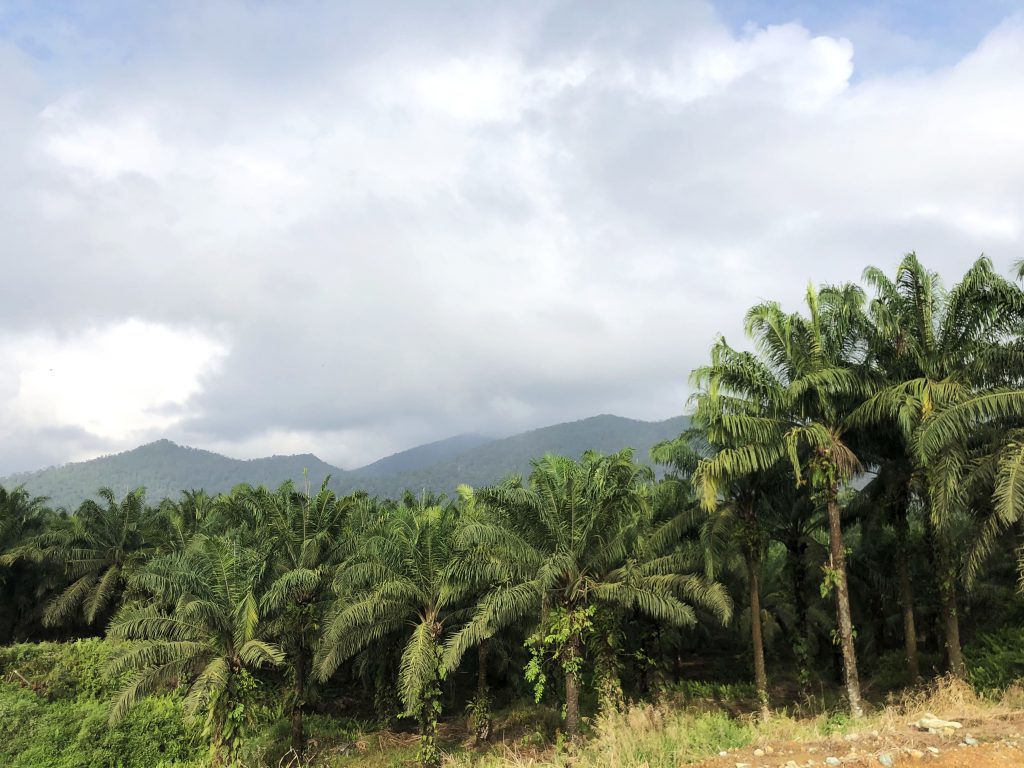
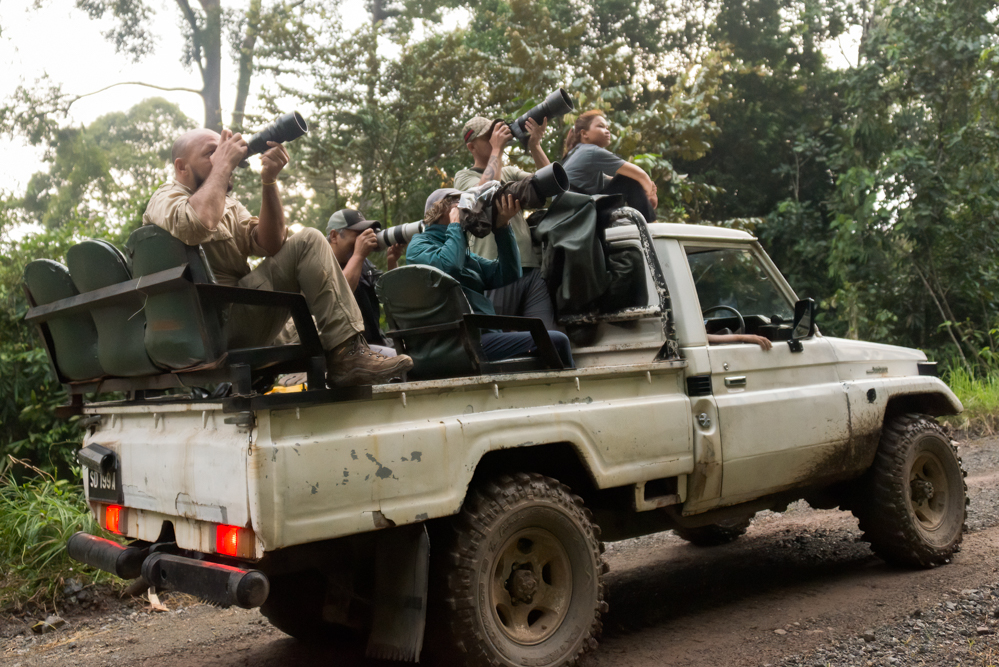
Deramokot Forest Reserve comprises of 55 507 hectares of lowland rainforest situated in the middle of Sabah. And, although logging does take place within its boundaries, the reserve has been certified as well managed. Getting to Deramakot is no easy task. On top of the bumpy 25 km road in from the highway – which took us a total of 90 minutes to navigate, we required a visitor’s permit from the Sabah Forestry Department, and in order to qualify for this, we needed to be accompanied by an experienced guide. The reserve can host 31 tourists at one time, but lucky for us, we were the only four for the duration of our stay. We had definitely found the intimate jungle experience we sought and were eager to begin searching for the ultimate find – the Sunda Clouded Leopard.
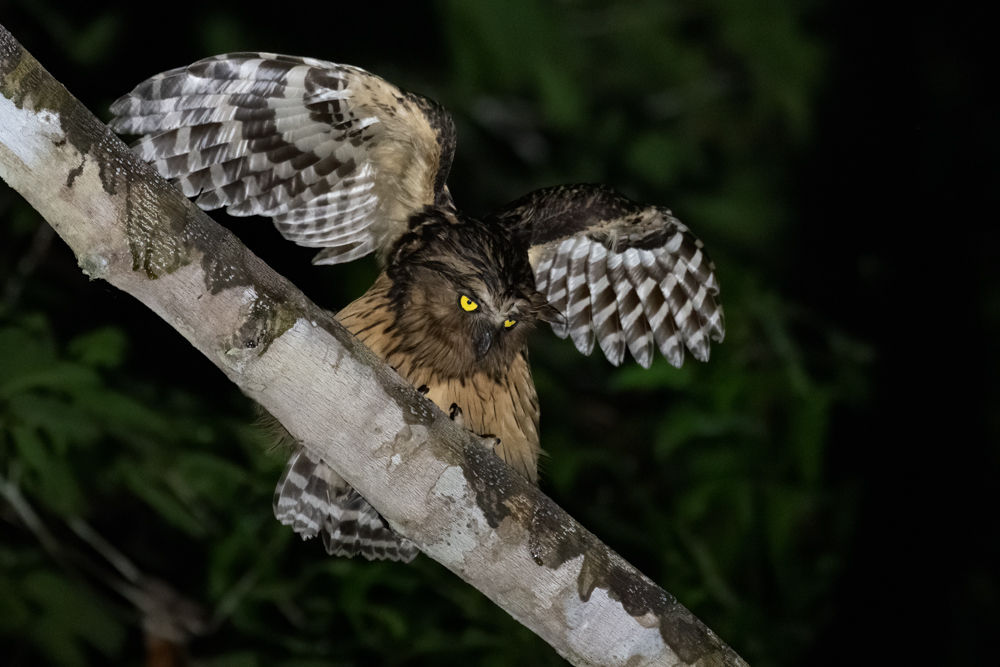
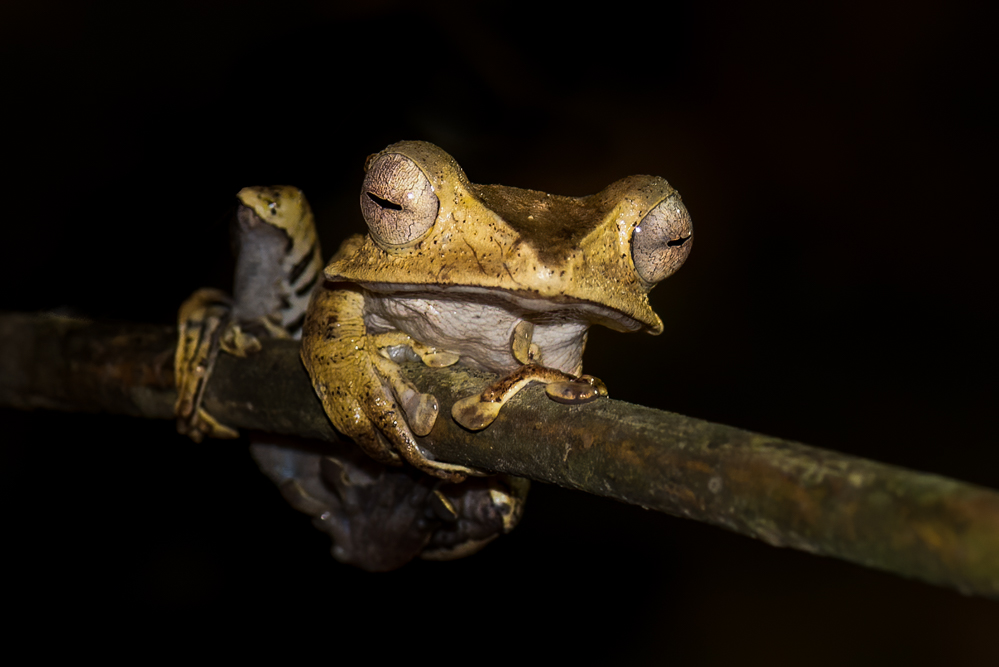
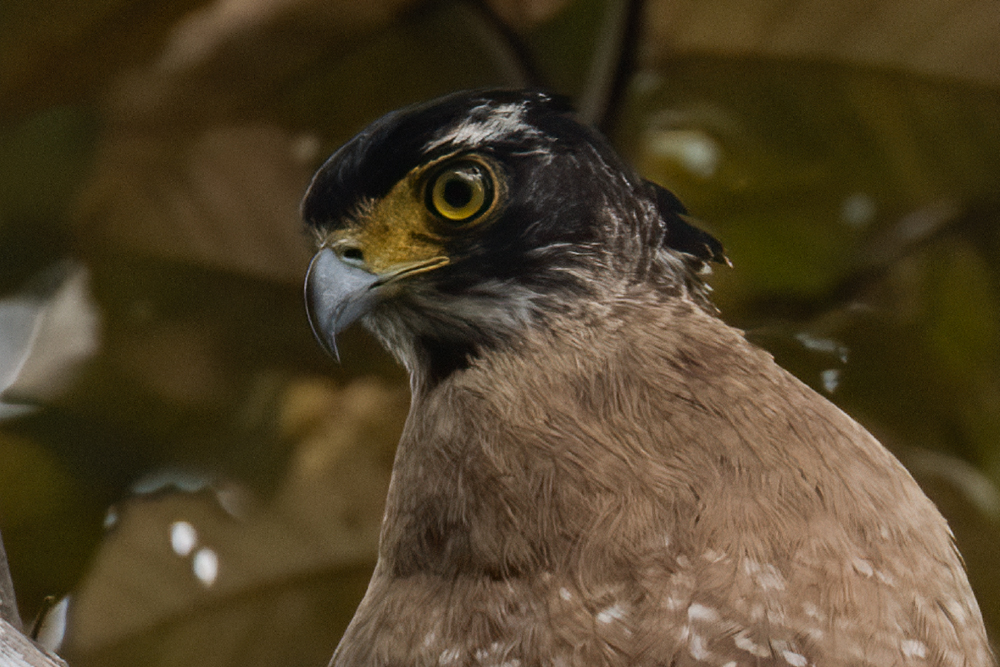
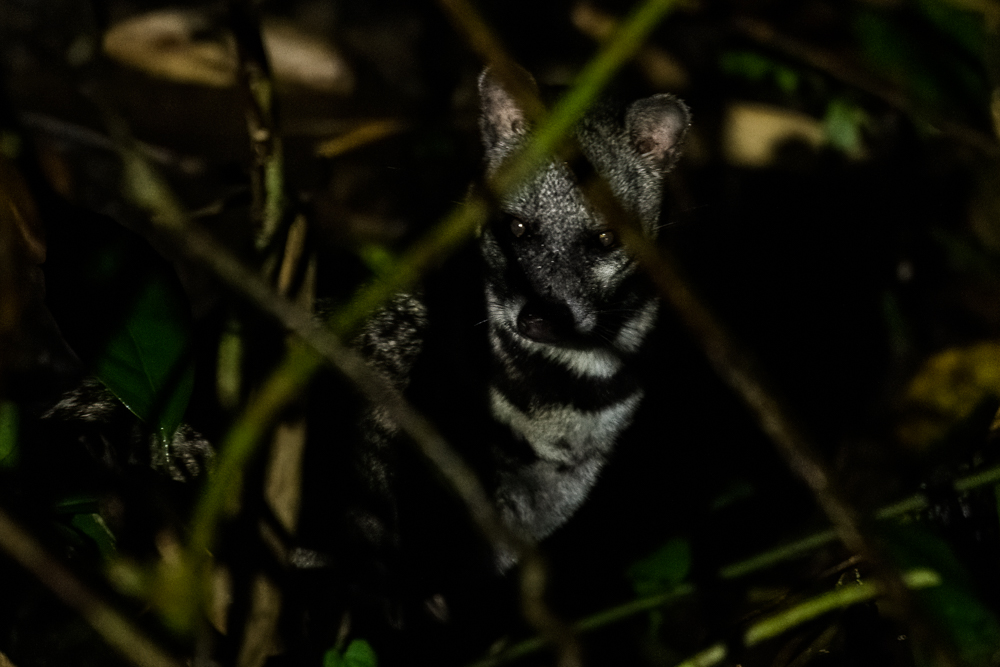
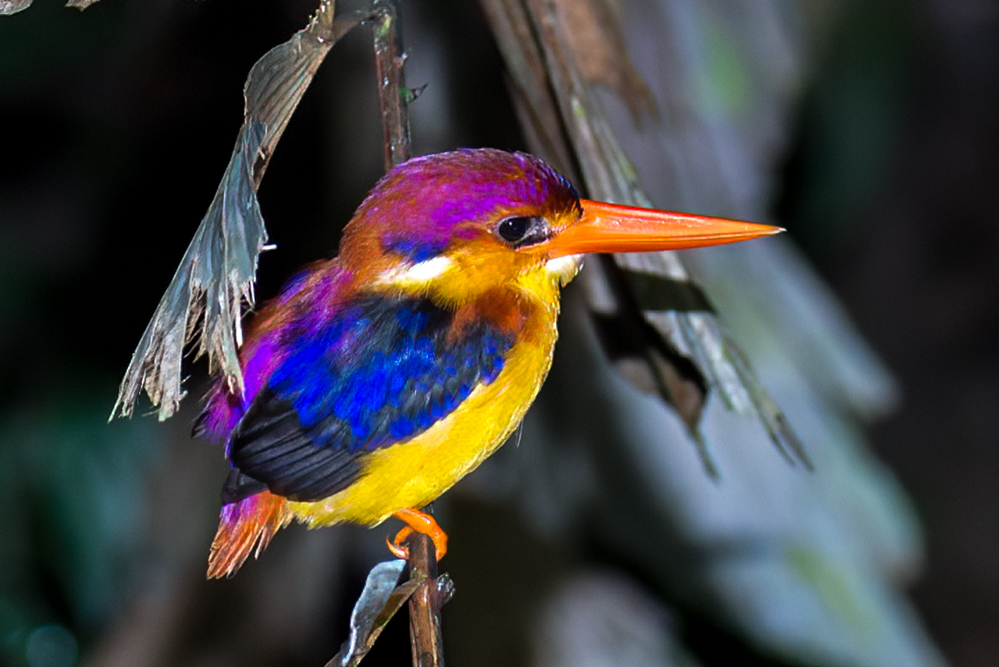
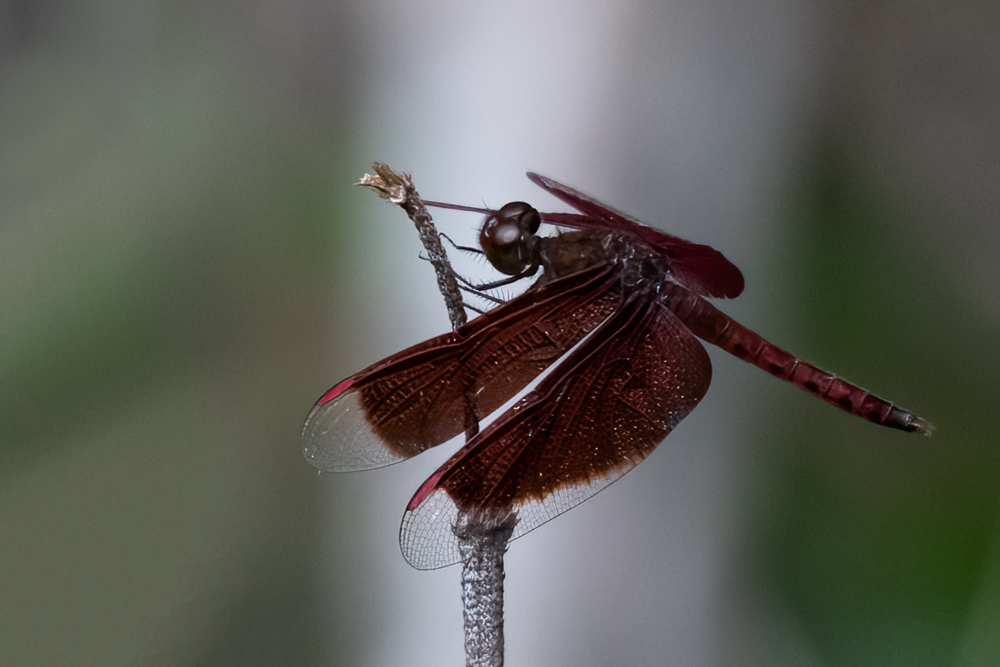
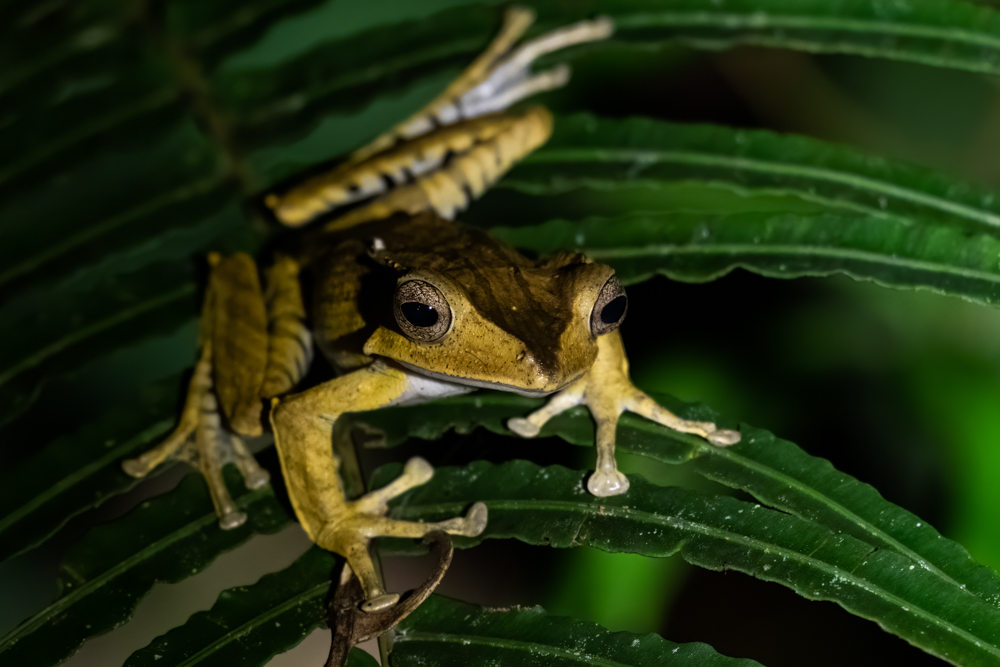
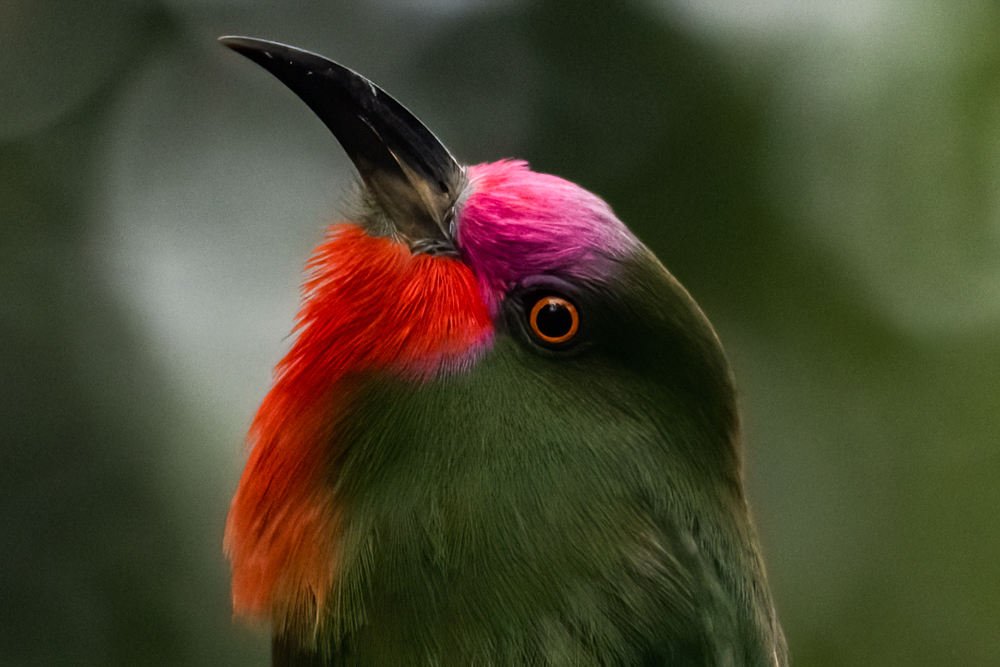
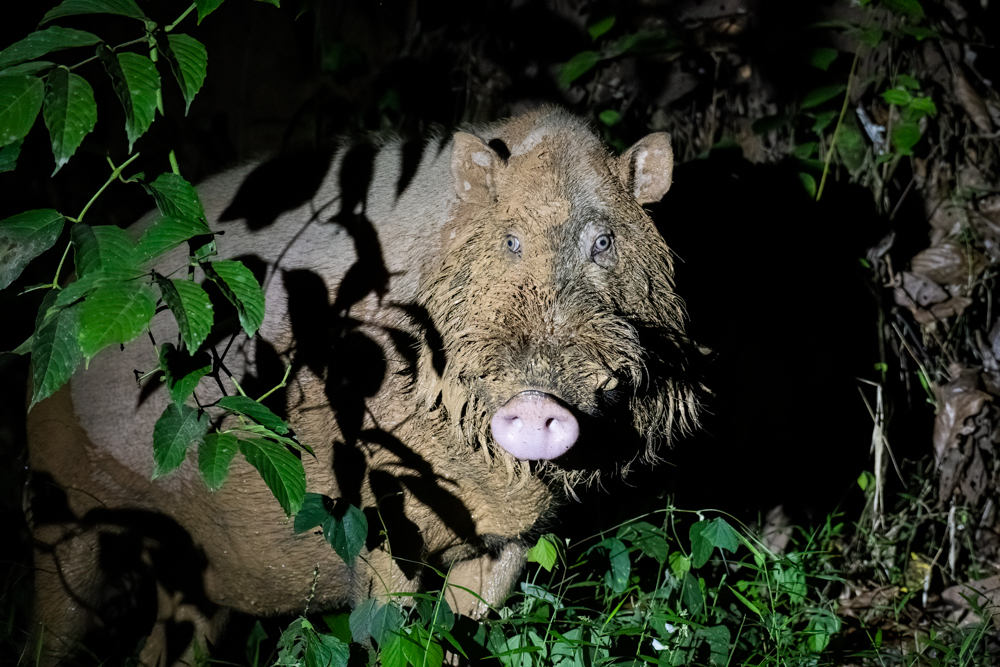
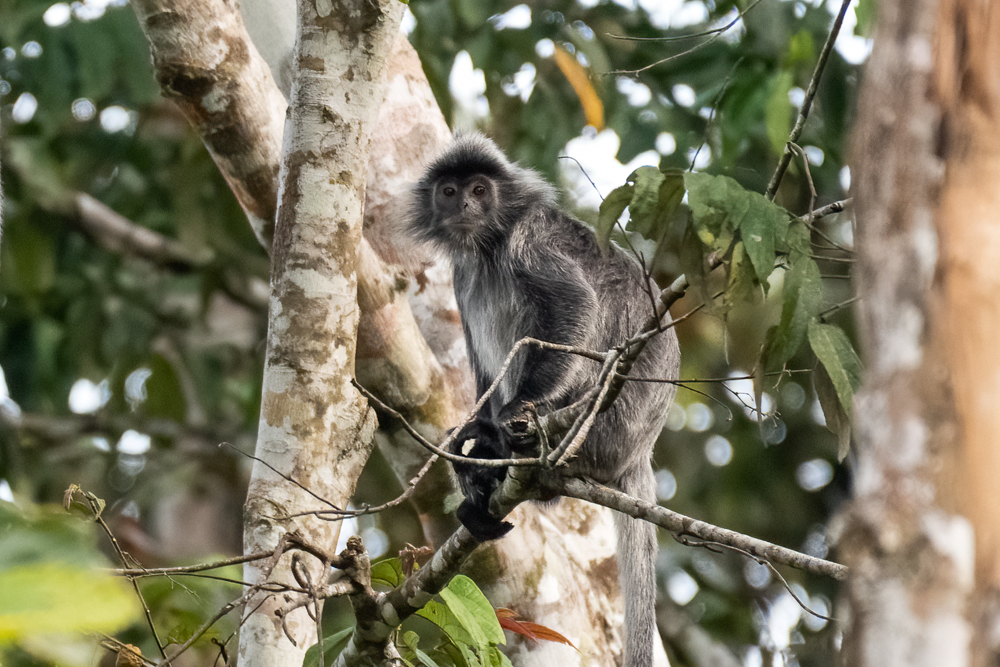
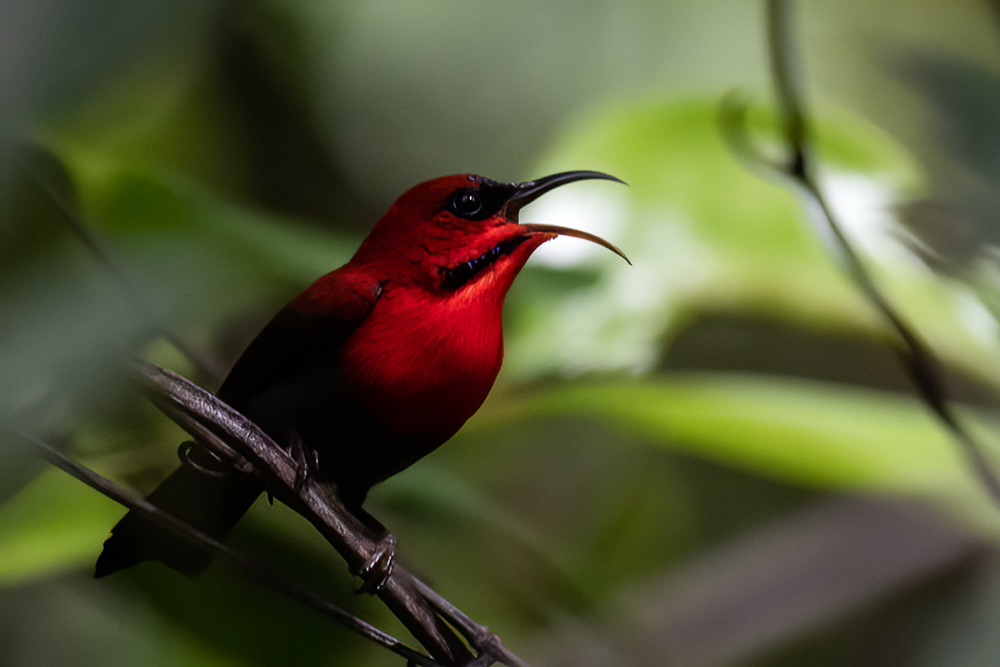
For three days, we searched and snapped and drove. We were up early and out late. We completed one day, two evenings, and one night excursion, all multiple hours in duration, hoping to catch a glimpse, and maybe a photograph, of our top three – Sunda clouded leopard, wild orangutan, Borneo Pygmy Elephant. We even hiked one of the trails around our camp in the afternoon heat. We saw bats, lizards, spiders, and monkeys. Evidence of the elusive elephants littered the road in large clumps. We were battered by driving rains and stifling heat. We saw Kingfishers, a colugo, and langurs. We found the small leopard cat but no clouded leopards. Still we pushed on. And I must say that Adi and Mike (@wildlife_of_borneo) are rock stars of the guiding profession. One on the hood and one on the roof of the truck, for countless hours in sometimes dismal conditions, they painted the trees with their beams of light in a determined, continuous crisscross pattern of anticipation. They rhythmically scanned for eye-shine – the telltale give-away of nocturnal species. They spotted frogs, owls, civets, deer, and wild boar, and so much more for us to photograph. And yet the top three remained invisible, until on our final tour, Eli spotted a large mature male orangutan – that we later dubbed Big Red – foraging on the ground near the road. We scrambled out of the box and like the paparazzi closing in on a celebrity, we vied for the best position to capture the selling image of this beautiful primate. In the aftermath, we celebrated with high-fives and smiles all around. We had checked the first box on our list of must-sees!
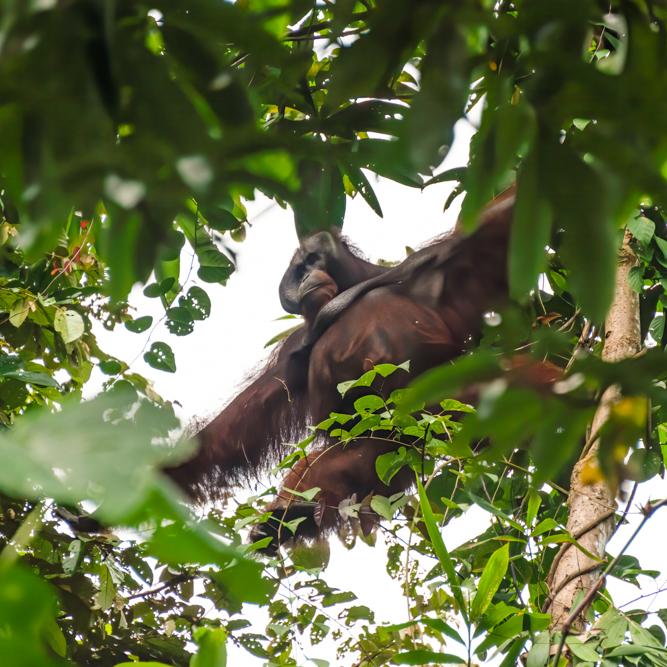
The River That Leads to the Sea
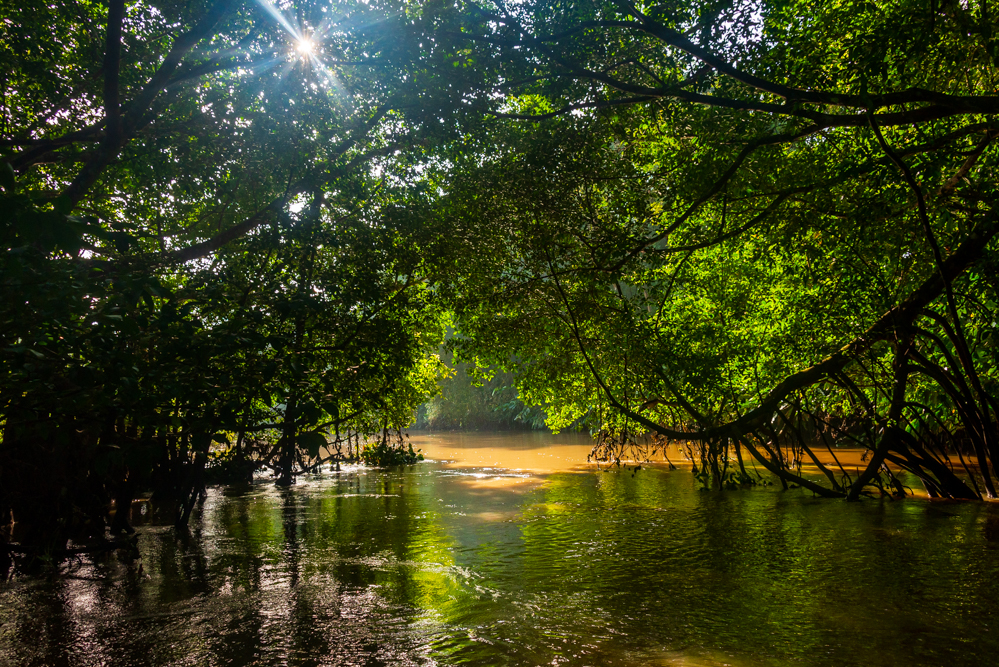
From Deramakot, we traveled to the Kinabatangan Wetlands Resort, located on a small tributary to the main river for our final two days in Borneo. In stark contrast to Deramakot, KWR was a five-star accommodation consisting of detached bungalows with every amenity imaginable. We had arrived in the lap of luxury. Yet our new reality was overwhelming after our intimate adventure in DFR, and I was somewhat saddened by the change. But then, the Kinabatangan River gifted us with a life-altering encounter and my melancholy was quickly replaced by its incredibleness.
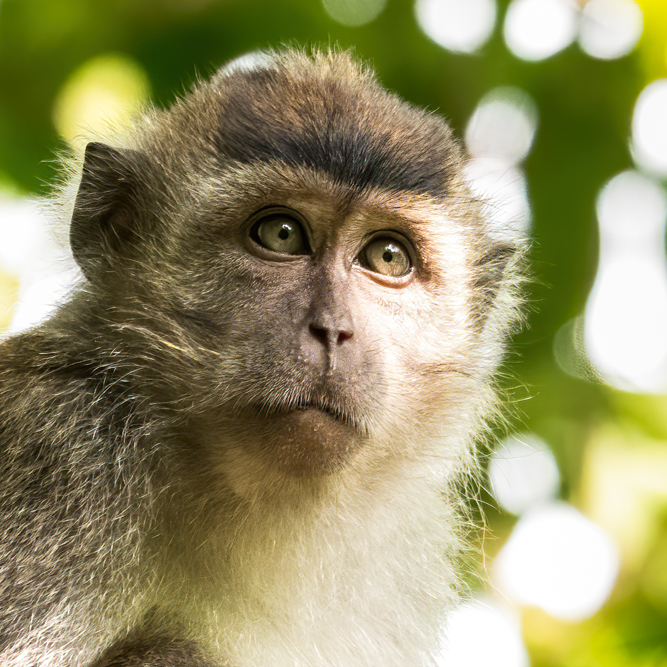
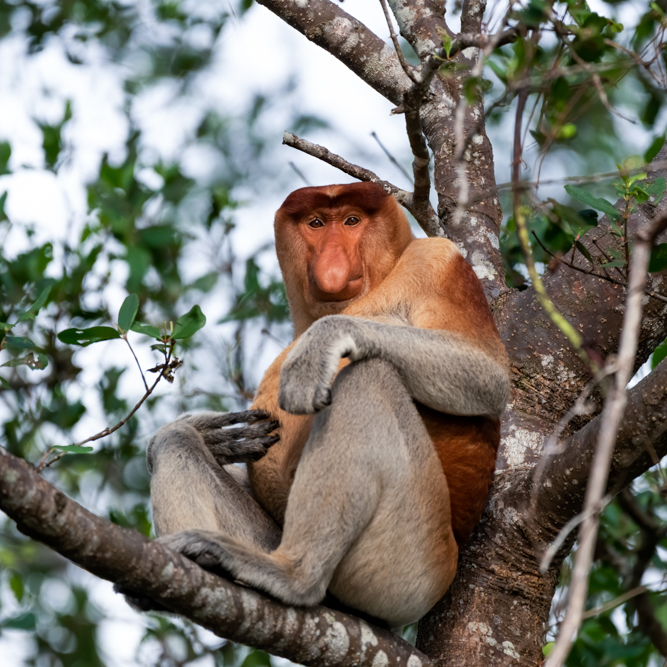
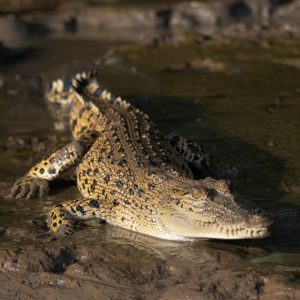
But before I get to that, the moments leading up to our ultimate encounter were not without their own magic. We saw many species of bird that fished in the river or that foraged in the fruit trees along its banks. We spotted silvered langurs, proboscis monkeys and some long-tailed macaques. We photographed nocturnal species – such as sleeping kingfishers, crocodiles, frogs. We were treated to tunnels of mangroves that offered a welcomed break from the sun. And on our night tour, Omar, our guide, treated us to a unique experience that, unfortunately, I could not capture with my camera. In an area along the shore, Omar had us turn off our torches and in the blackness the trees around us twinkled as if decorated by strands of lights. I was awestruck. Everywhere I looked the lights danced in the trees, the glow produced by the bioluminescent trilobite beetle. So to say that we had only one amazing experience would be false – there were so many. And although this blog is definitely long-winded, it is only a few excerpts from the journal I wrote!
Along the Banks of Paradise
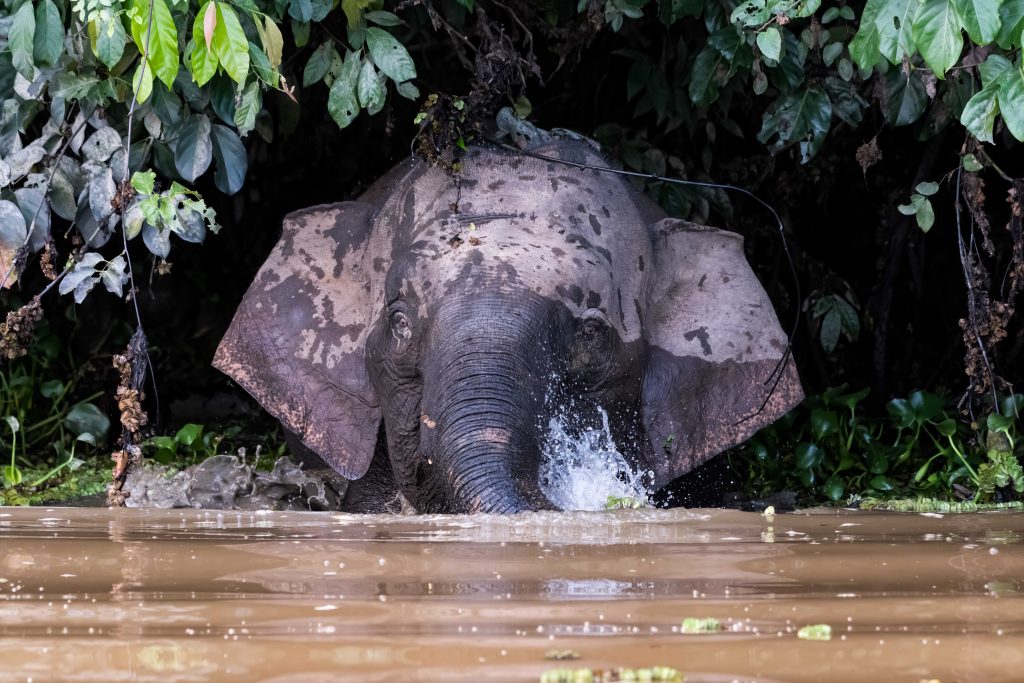
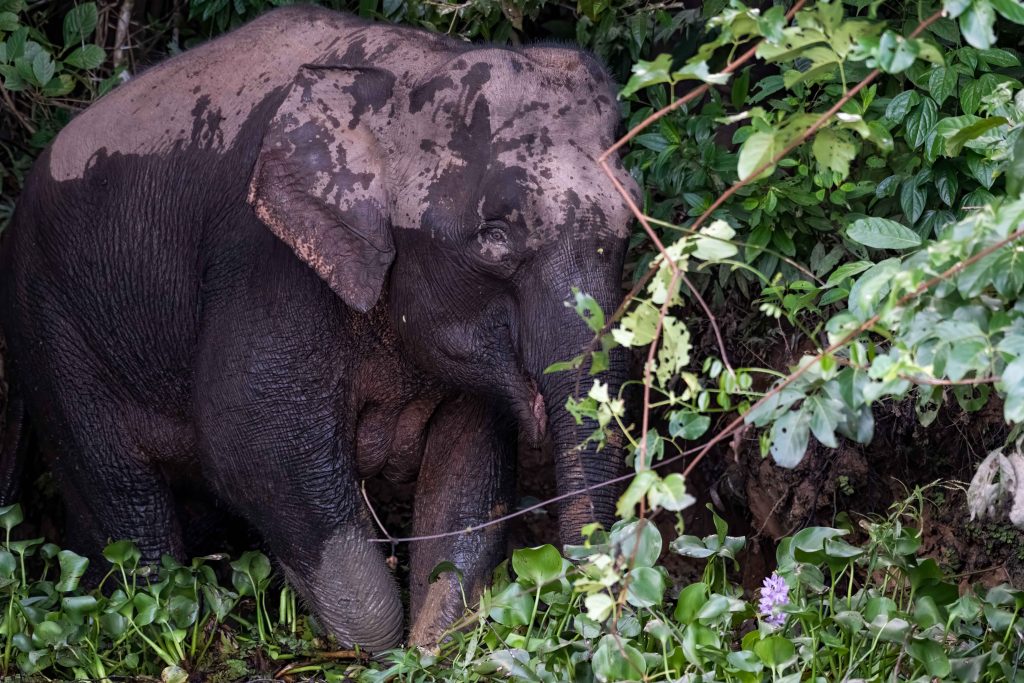
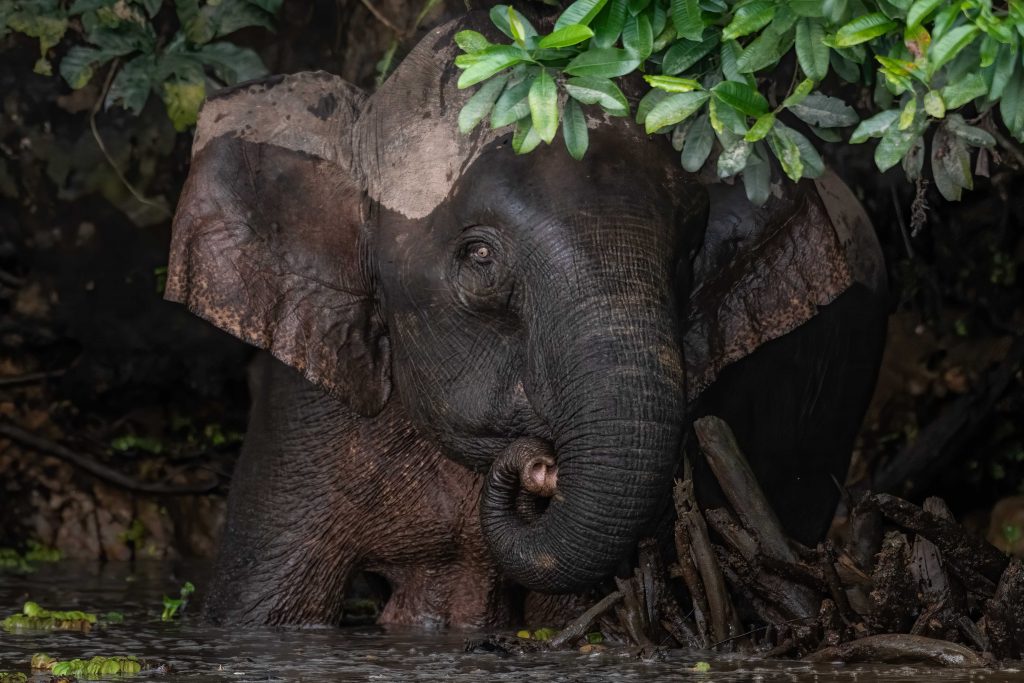
On our final day of river-touring, with no sightings of orangutans or elephants along the banks of the Kinabatangan, we opted to search for the rhinoceros hornbill. This bird wasn’t one of our top three, but it was a close fourth and we hoped to find it feeding on the fruit trees that lined the banks of a smaller tributary. Trekking on one of the trails of Deramakot, we had a brief encounter with this beautiful bird at which time I managed to capture a meager two frames. But I was the only one who got a decent picture and the others wanted their opportunity to do the same. As we meandered southward, we noticed several tour boats lining the shore ahead of us. As we neared closer, we were greeted with the most amazing sounds and offensive smells. Dotted along the edge of the river were dozens of Borneo Pygmy Elephants! Trunks, and ears, and massive feet covered the area just inside the bank. For the next three hours, we enjoyed the company of these amazing beasts – first with several other guests. Then as lunchtime neared, and the others dispersed, only our boat remained. Captivated by the scene before us, we completely forgot about trying to locate the hornbill. We were awestruck as some of the elephants demonstrated their swimming prowess. Others were content to forage, and a couple were quite intrigued by us. Unfortunately, the herd was rather protective of their young and the babies were kept back from the river’s edge. As I bobbed left and right, up and down, to get a clear shot of a tiny elephant, I upset the female protector closest to me and she started trumpeting – and the rest of the herd responded. Their blasts were almost deafening. In addition to the screams resonating from their trunks, there were grunts, growls, and pounding feet. The female closest to me moved closer. It was an intense moment that has been forever chiseled into my memory. I sat down, and the herd calmed. They had imposed their boundary and I planned to respect it. Over the next hour, we snapped and watch and marveled and as our cards neared capacity we felt the time had come for us to say goodbye.
We had been blessed by Mother Nature over the course of our adventure and we were truly grateful. Sure we hadn’t seen all that we had hoped to yet our experience in Borneo had been nothing short of magical. On our final boat ride to the mouth of the Kinabatangan, I reflected on the effect this experience in Borneo had, and would continue to have, on my life. I thought about what I was bringing back with me. Memories for one – of Big Red swinging from one branch to another, of beetles twinkling in the moonlight, of the herd of 100 strong lining the shore. Photographs for another – images that tried to convey the incredibleness of what we had witnessed. Friendships as well – with those who share my passions and interests. And most importantly – respect for the people I met who work tirelessly in ecotourism to help the forests and its inhabitants survive against an onslaught of deforestation, exploitation, and greed. As I boarded my flight home, I couldn’t help but think that I needed to return one day to complete my bucket list. Thankfully, because of the dedication of people like Adi, Mike, and Omar I might just get the chance to check the rest of my boxes!
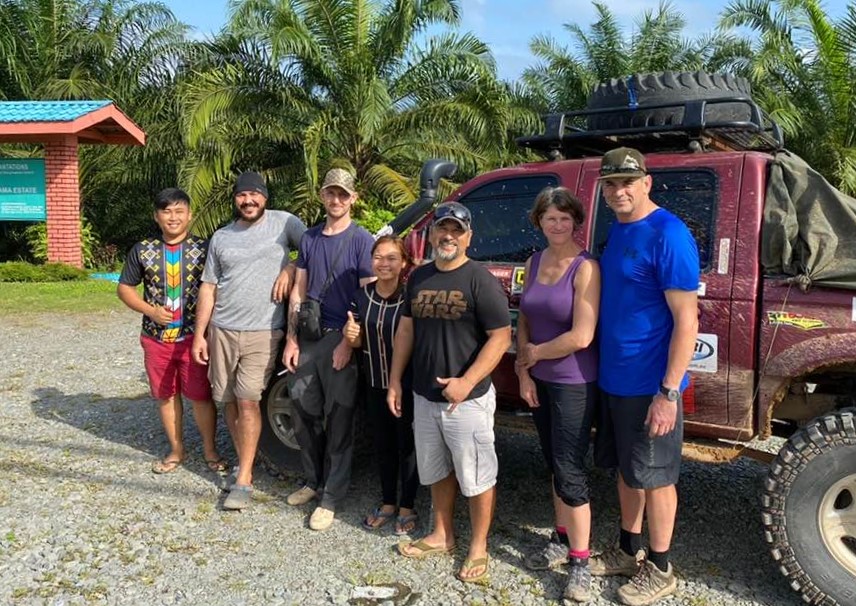
My Adventures in Borneo - February 9-15, 2020
Owling: My Addiction Exposed
You may be shocked to learn that I haven’t always been a birder. In fact, I used to scoff at those binocular wielding nerds, dressed in reed-coloured clothing, gawking at some winged creature. So why now have I become one? I believe to some extent, my transformation has resulted from a genetic predisposition in my paternal DNA. My father was an armchair bird enthusiast and he created a sanctuary for his feathered friends in our postage-stamp front yard. From the enormous spruce, flanked by two Schubert chokecherry trees, to the feeders, houses, and bird-baths, he offered five-star accommodations for both the residents and the wanderlust. With his morning coffee, at mealtime, or as the sun would begin to set, he enjoyed the songs and antics of his avian visitors and found great satisfaction in the peacefulness of this passive pursuit. He was a classic bird-watcher – content to see and marvel from the comfort of his four walls. That is the difference between him and me. He was a spectator on the sidelines and I must be a player on the field. For me, birding is an extreme sport in which I am actively pursuing birds. In this highly competitive event, my goal is to find a new species, manage a behavioral photograph, and most importantly – out shoot Cindy! Just kidding. My friendly rivalry with my cousin drives me to become a better photographer, just as teammates push each other to excel, and together we have crisscrossed much of southern Manitoba in our pursuits and have amassed quite the portfolios. One of our favorite targets during our day-long drives is the owl – any species of owl – as this elusive creature is difficult to find, let alone photograph. But, any sport is more enjoyable when played against a formidable opponent – and the owl, definitely qualifies! Luckily for us, Manitoba experienced a winter bird irruption and we were able to locate the four different owl species showcased below. Finding one or two species would have been satisfactory. Spotting four – one of which neither of us had previously photographed, was truly exhilarating. Achieving this level of success is extremely addictive, an adrenaline rush of sorts, and I am forever chasing the next ultimate encounter.
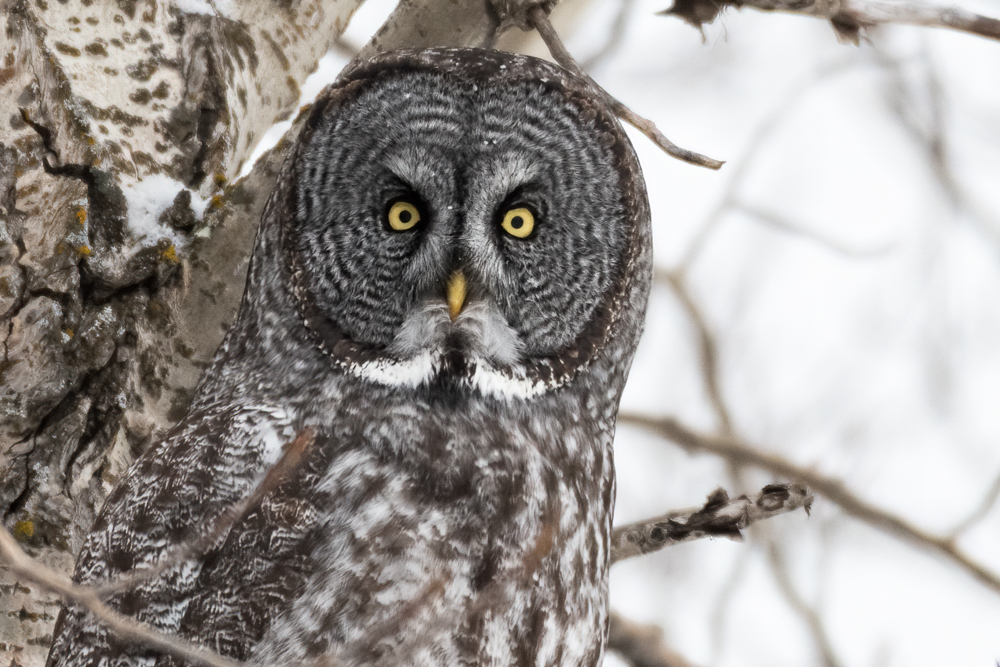
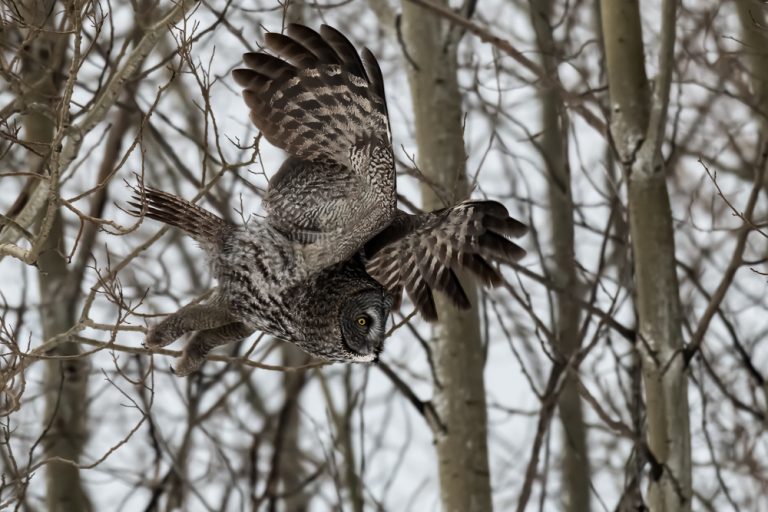
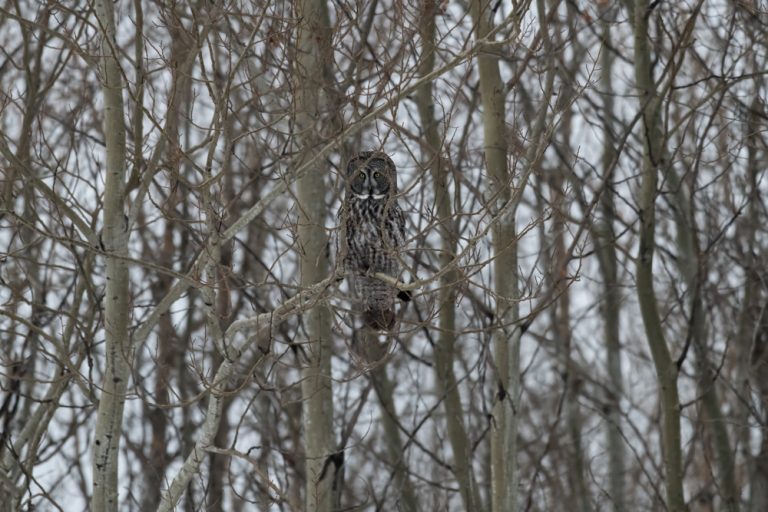
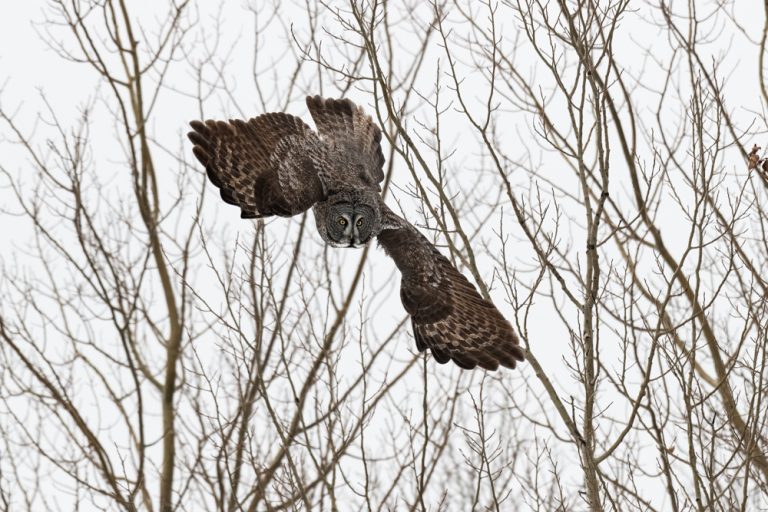
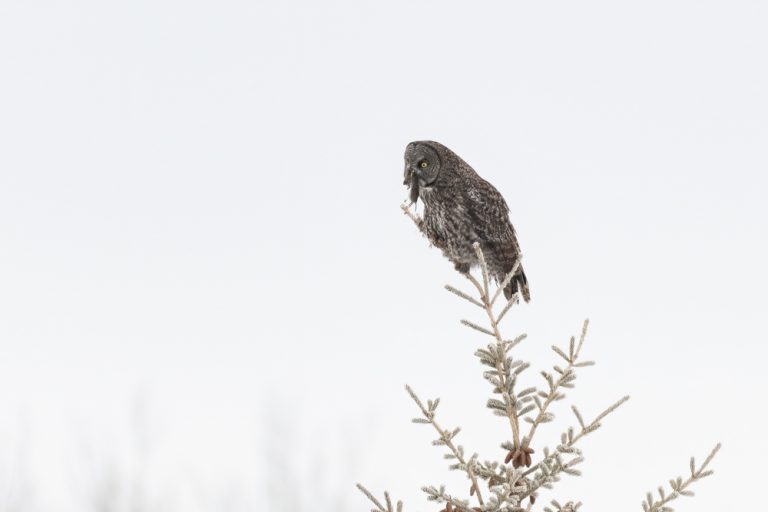
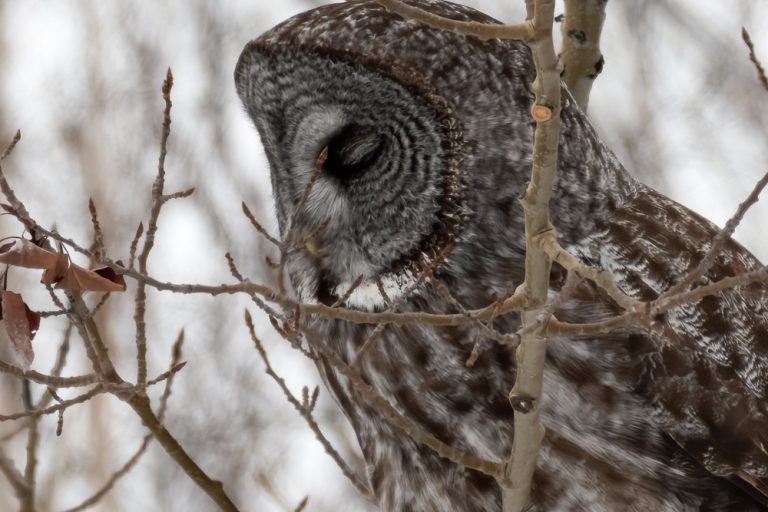
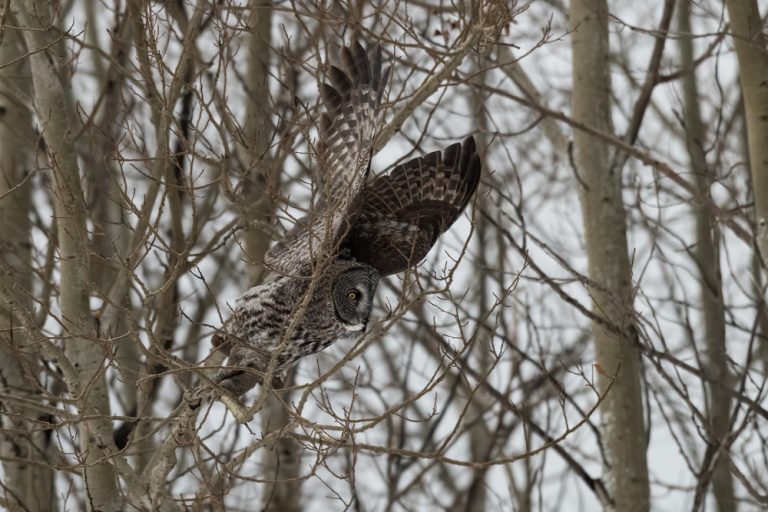
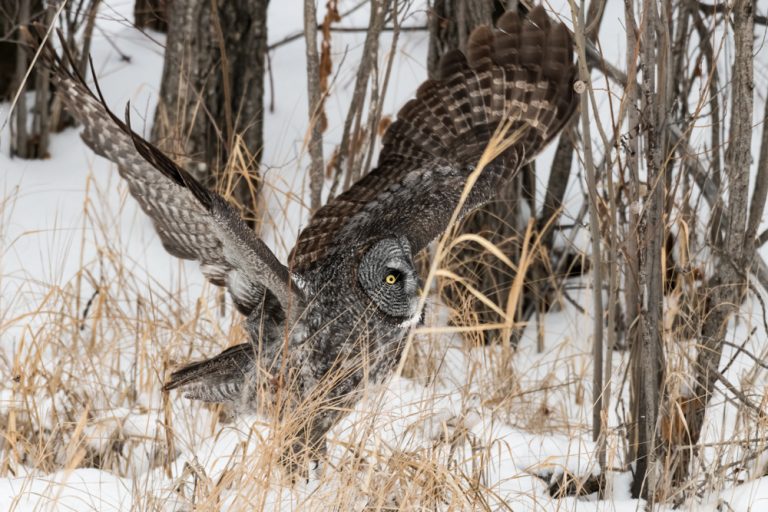
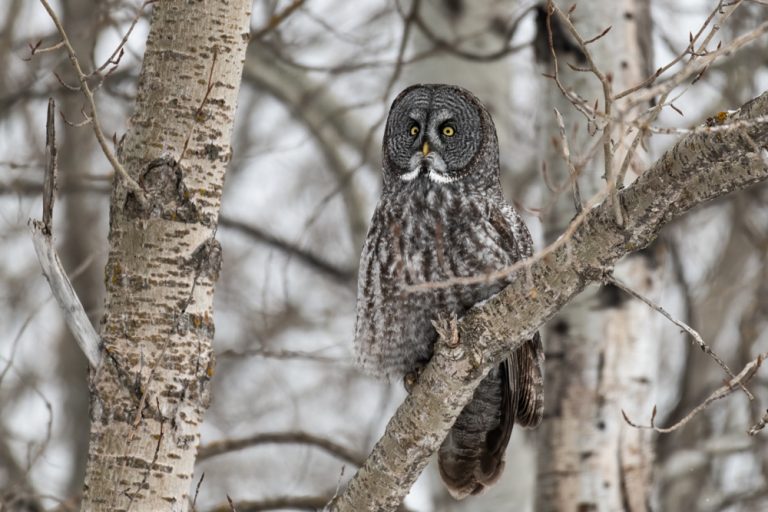
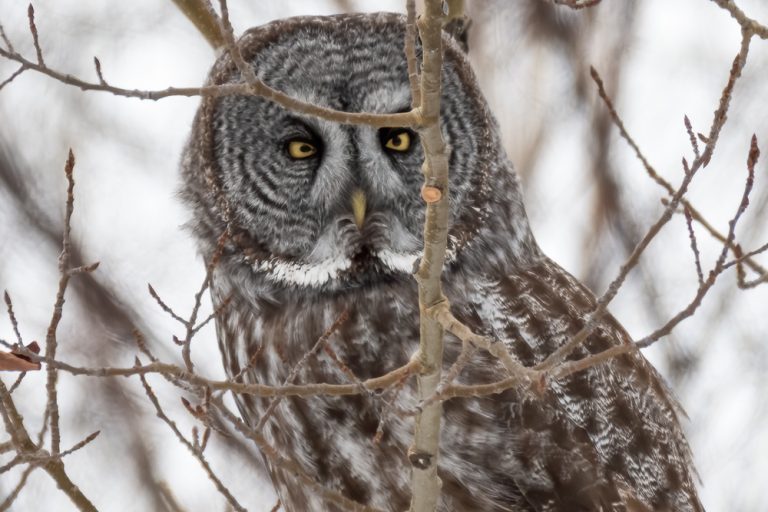
Just after the new year, we decided to search for the Great Grey Owl (Strix nebulosa). Several other birders had been successful in locating this iconic beauty so we headed out one January morning in hopes of the same. My only previous sighting of a Great Grey Owl was back in 2017 in Riding Mountain but that meeting had been far too brief and resulted in only a handful of images. But 2017 had been a year of nearly no sightings and now, according to all the online posts, the Phantom of the North seemed to be everywhere. These reports made us cautiously optimistic that the day’s encounters would be more plentiful and much more fruitful. And I’m happy to say that we were not disappointed. After our three hour drive to the forests of eastern Manitoba, we spotted our first specimen hunting voles on a quiet gravel road. Big, bold and beautiful, this denizen of the boreal forest was a joy to observe. For close to an hour, maybe more, we watched him hunt, unconcerned by our quiet presence. At times he would close his bright yellow eyes, but the slightest movement or noise, and his keen focus would be back on the forest floor. Occasionally, he would dive towards a possible meal, his large wings silently propelling him downward. After each fruitless attempt, he would return to his perch and ready himself for the next opportunity. We never witnessed this particular owl acquire a meal, so we decided to leave him to the task at hand, fearing that our presence was impeding his success. As fortune would have it, we spotted three more Great Greys that afternoon and as the light faded, we even witnessed one snag a vole from the snow covered ground. This truly was a banner year for this amazing creature and I feel blessed to have watched him in action on this occasion and on one or two more.
Our second owl of the winter search was the Northern Hawk Owl (Surnia ulula). This medium-sized bird has exceptional balance and watching him sway back and forth in a strong wind was truly mesmerizing. He, like the larger grey owl, isn’t fearful of humans and continued to hunt in our presence, only occasionally giving us his famous stink eye. It was a particularly frigid day, and this little guy had puffed out his feathers making him look more like a football than a to-be-feared predator. Yet he seemed undeterred by the cold as he continuously scanned the ground for his next meal. Of all the owls we photographed this species has the most personality and I especially love the way he tilted his head to one side making him seem more shy than curious. They are pretty easy to locate during the winter months as they are daytime hunters and non-migratory, still I treasured every one of our encounters. And, because I have not captured a passable image of him hunting, I will continue to scan the tree tops for this beauty whenever I can!
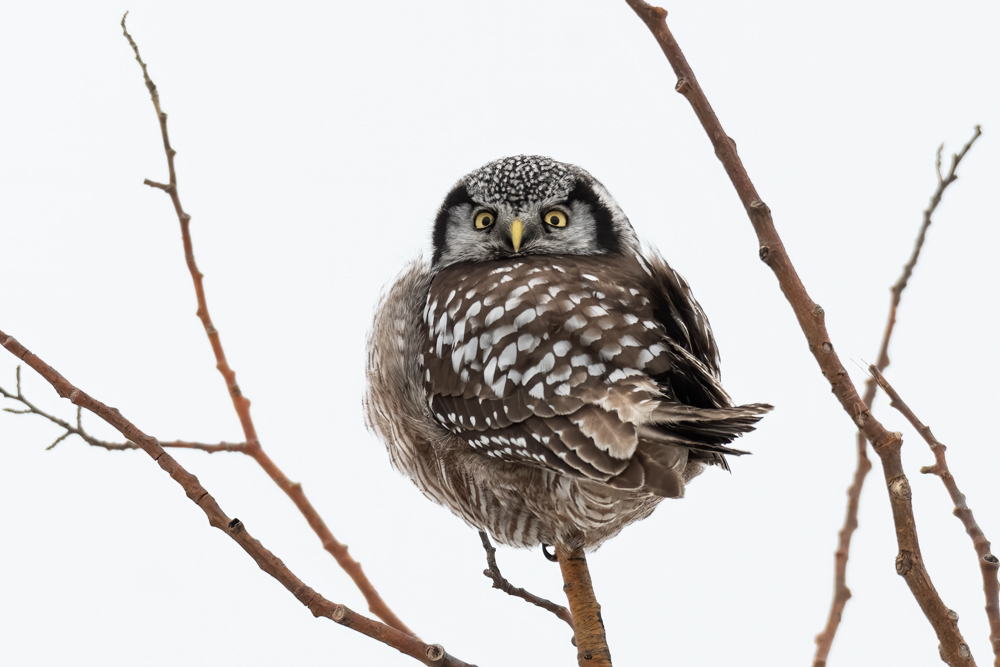
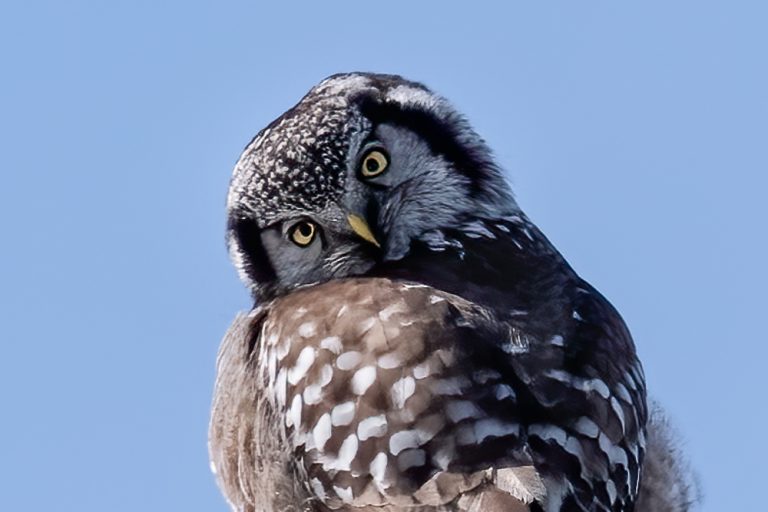
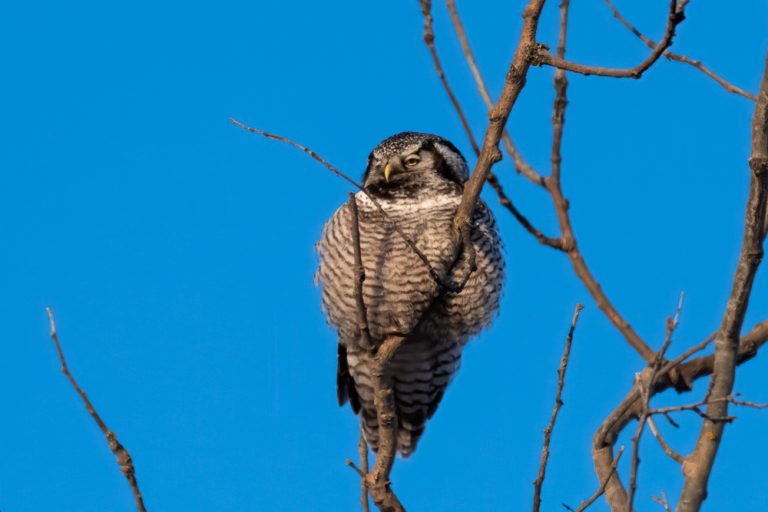
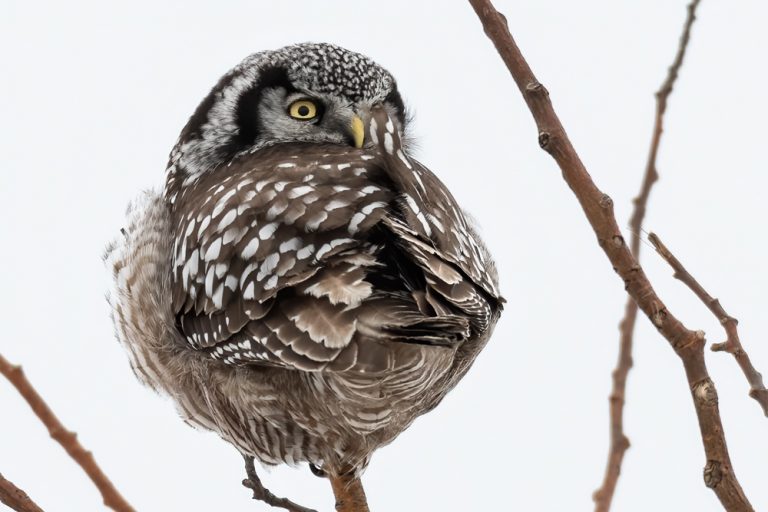
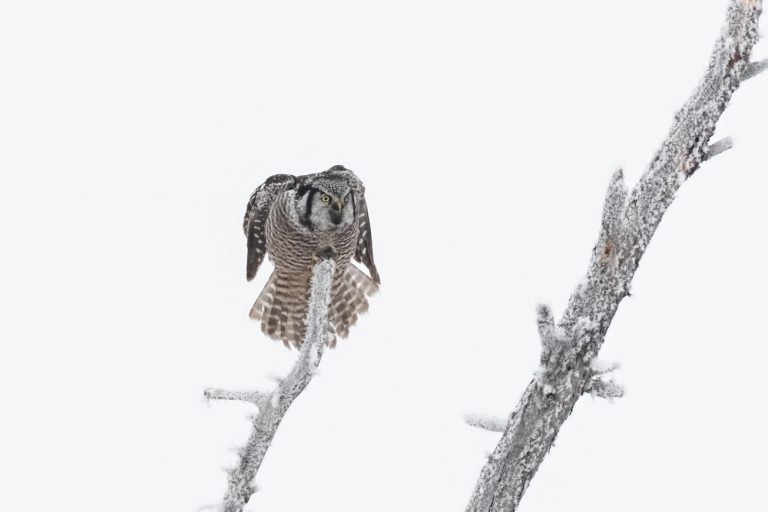
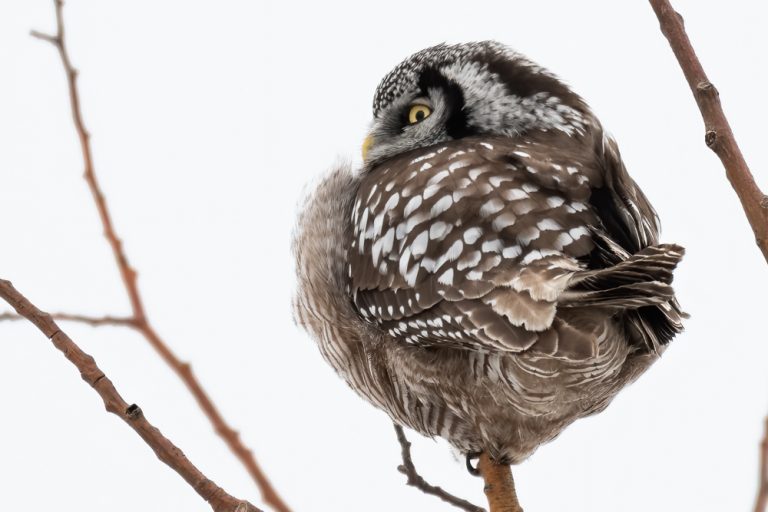
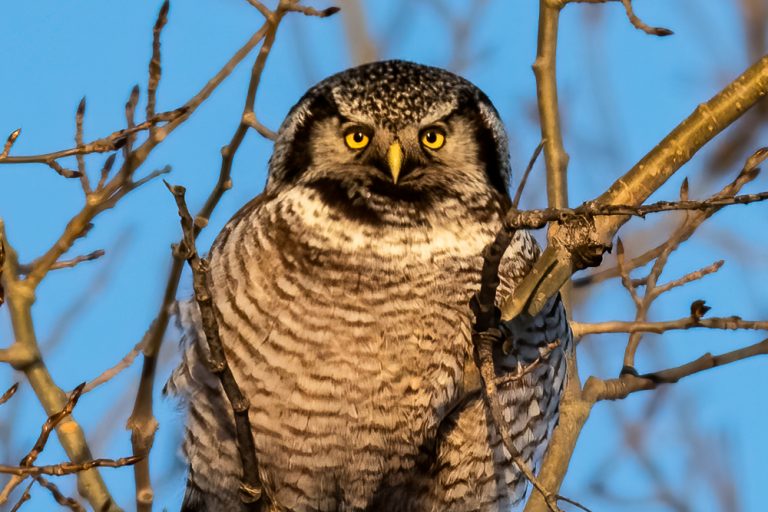
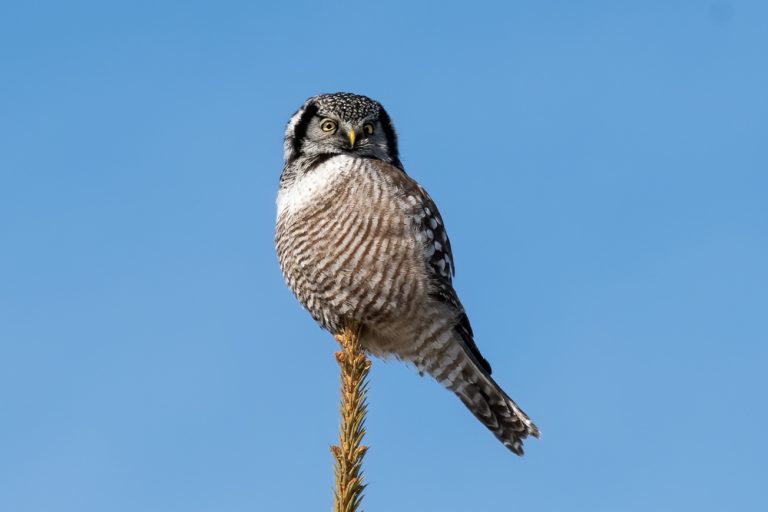
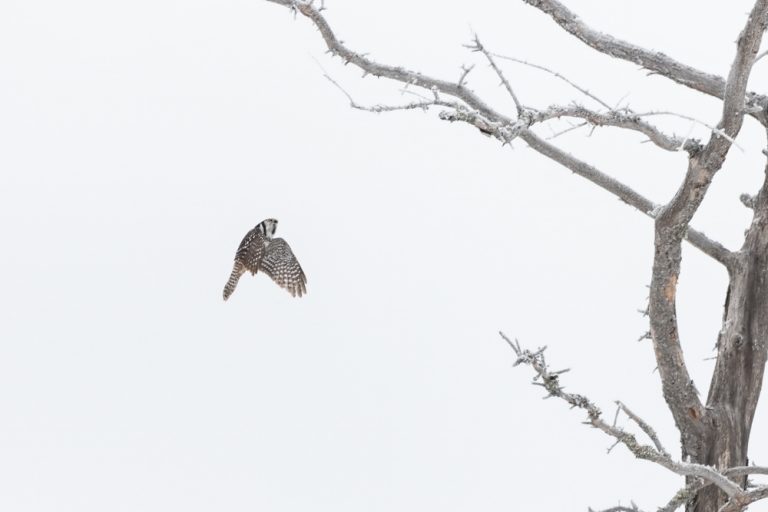
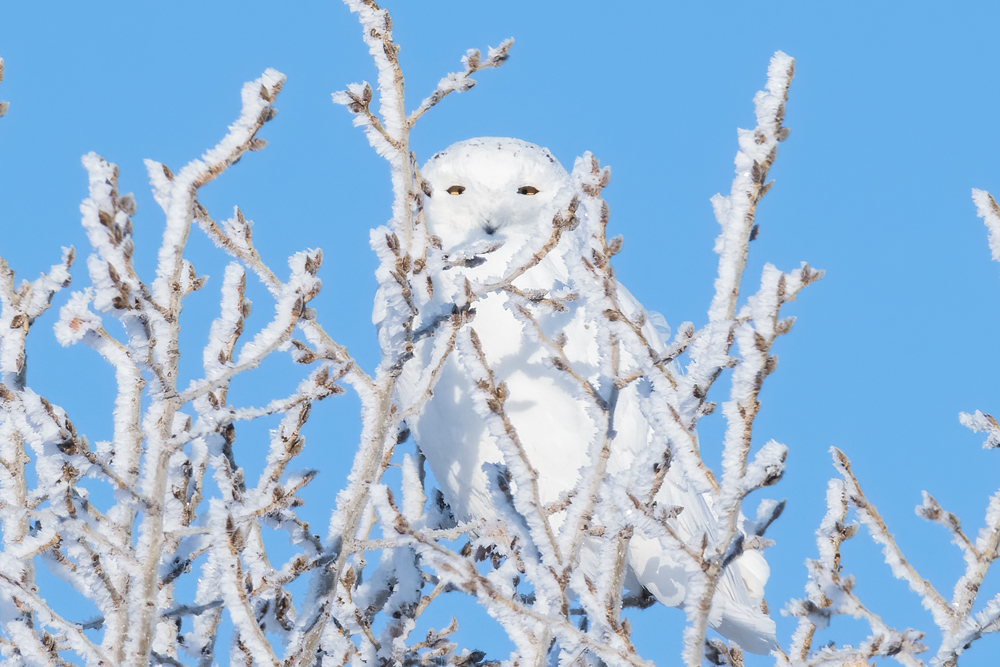
The Snowy Owl (Bubo scandiacus) was one of my frequently observed owls this winter since they can be usually found within a short distance of my house. As a result, I get more opportunities to photograph this species. I have been out with Cindy and on my own seeking this predator but in a more of a…We were on our way to…and we spotted a snowy. So this owl isn’t normally the purpose of the outing but a lovely add-on, and I don’t typically give them the attention they deserve. Unfortunately, they are more fearful of humans than the previous two, usually staying a pole length away, and they dislike the look of the camera. So getting images requires different strategies and more patience than I seem to have. Not to mention that winter here in Manitoba is frequently beyond cold, and I am less eager to spend the necessary time, while freezing my patooties off, to get the ultimate shot. I know. I tend to be quite a woose.
Also, as this beauty is a diurnal hunter, seeking food both day and night, I sometimes wonder if my daytime presence is interrupting nap time as most of my images are of an owl sleeping atop his hydro pole perch. His behaviour could be of course, the result of his hunting style – more of a patient sit and wait predator – but I’m still leaning towards sleep deprived. Thus my ultimate goal with each encounter is to capture this white wonder actively hunting. I have had the opportunity to witness a snowy just after a successful hunt but the distance was too great to document with my camera. I guess the experience alone will have to be sufficient till I get the chance for more! Sadly, as spring has arrived, my efforts will have to wait as I bid adieu to the snowy until next fall.
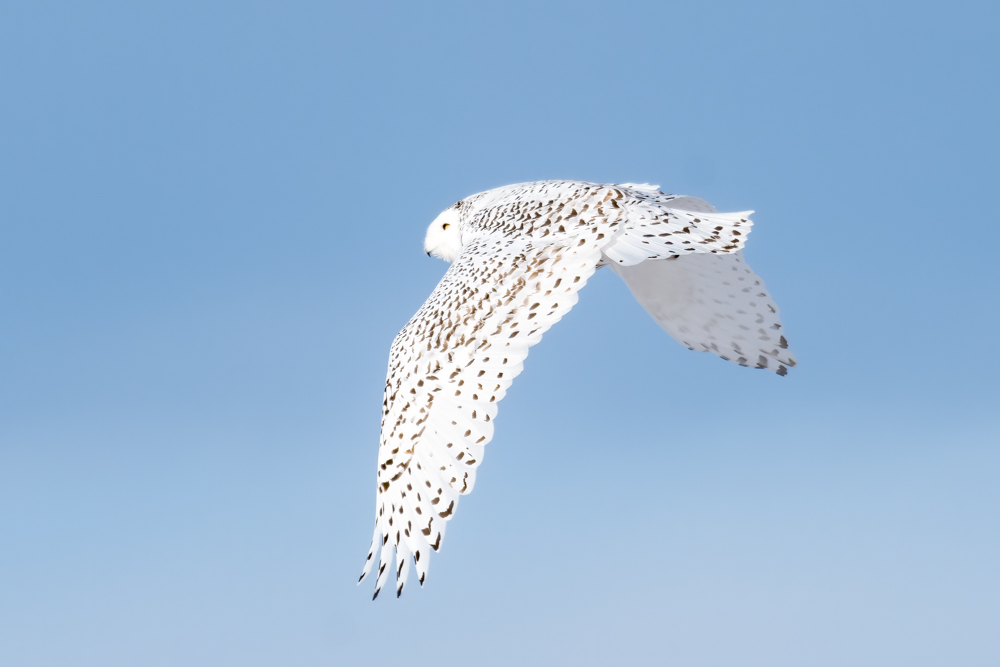
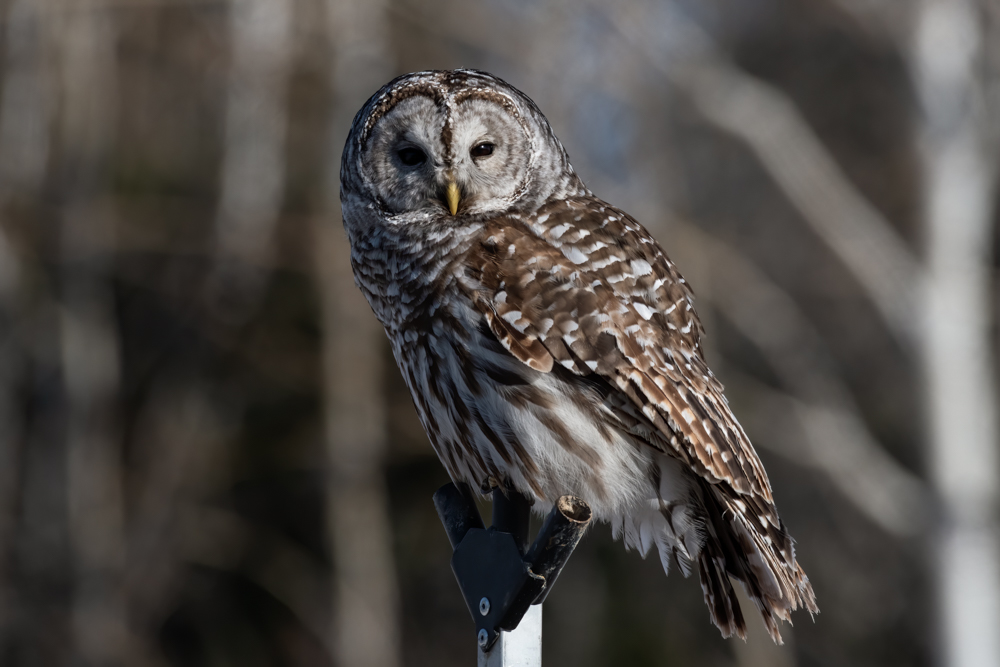
Our final discovery wasn’t one on our radar, and we really hadn’t even entertained the possibility of seeing one. We just happened by whilst he was snoozing on a road construction sign and thankfully, Cindy spotted him. We could have quite easily driven past as our gaze tends to scan the trees and not the area in the five-feet-above-the-road zone. Yet there he was – a gorgeous specimen just catching a few ZZs on a fairly busy highway. The shock of the encounter had me in a semi-trance and it took me a few minutes to get turned around and in position to capture some images. Luckily, he was pretty drowsy and had no intentions of fleeing the scene. Actually just keeping his eyes open seemed to be difficult enough and he let us snap quite a few frames before deciding to resettle on a tree a short distance away. Afterwards, we probably spent the next 45 minutes filling our cards with various poses. Finding this Barred Owl (Strix varia) has certainly been the highlight of my owling season. And I felt the need to share the experience. So, despite our better judgement, we left this owl nap uninterrupted for the next 30 minutes as we made a quick run to my sister’s and back so that she could get some images too.
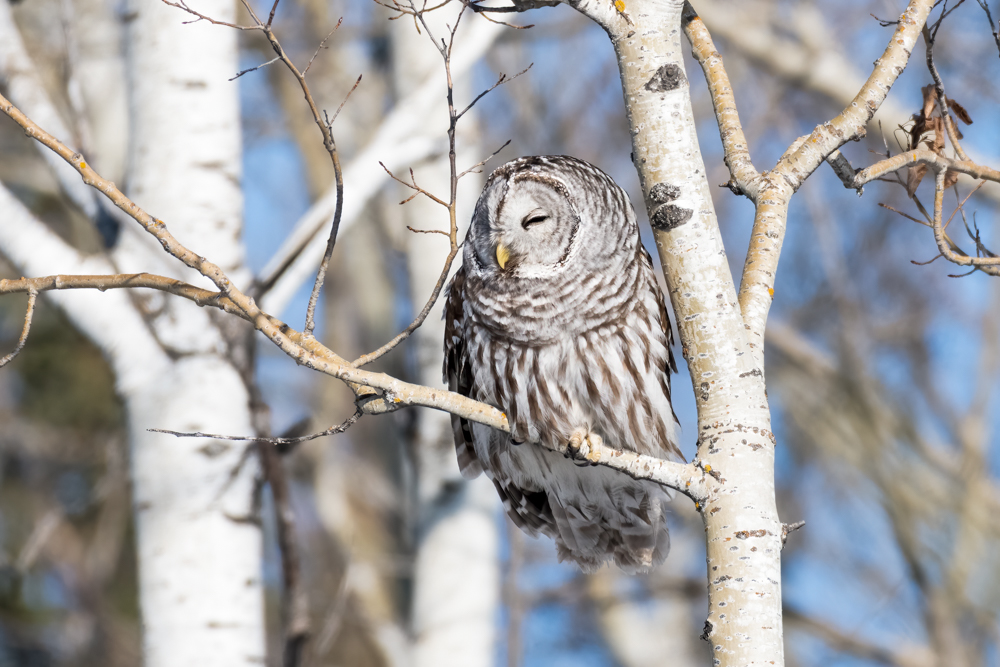
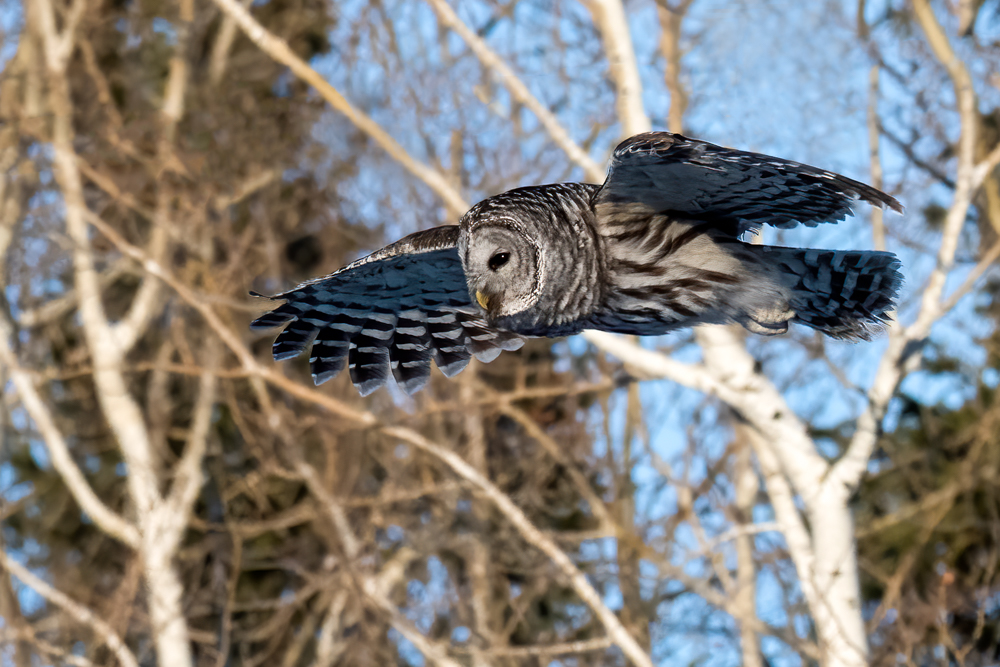
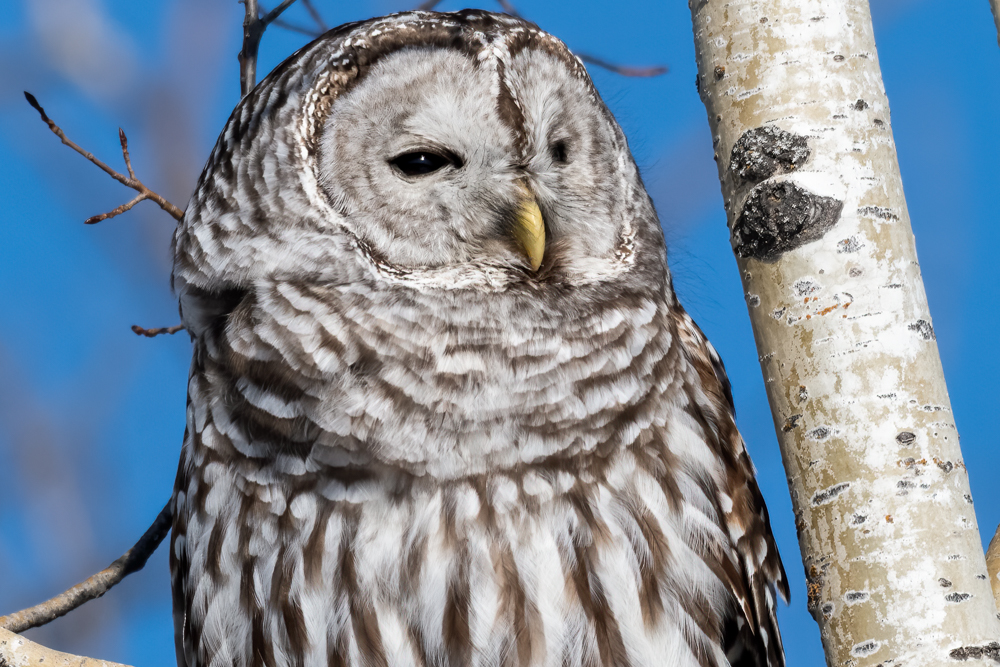
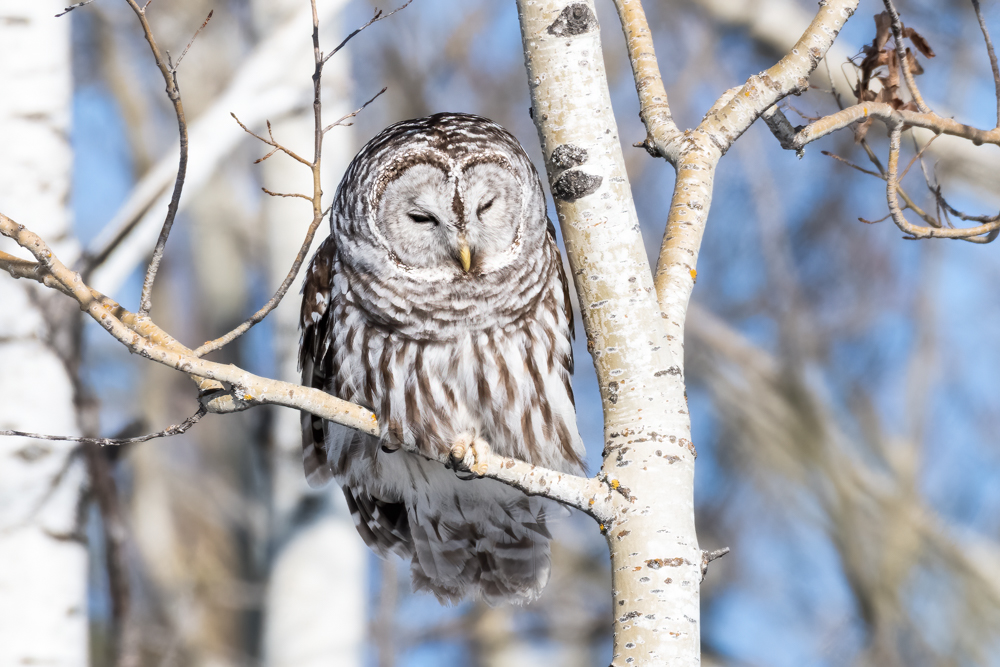
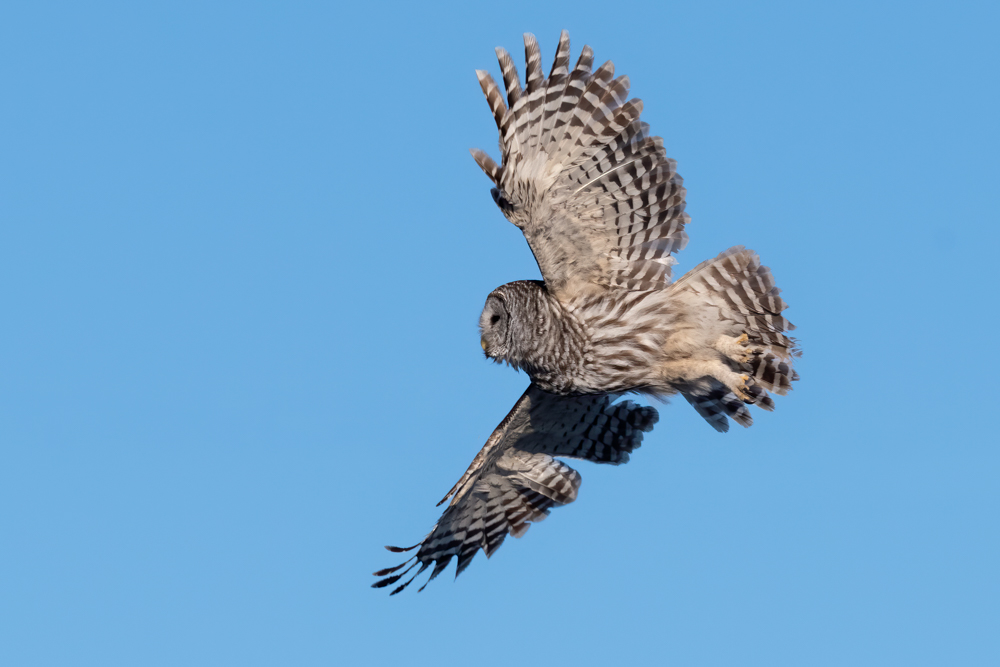
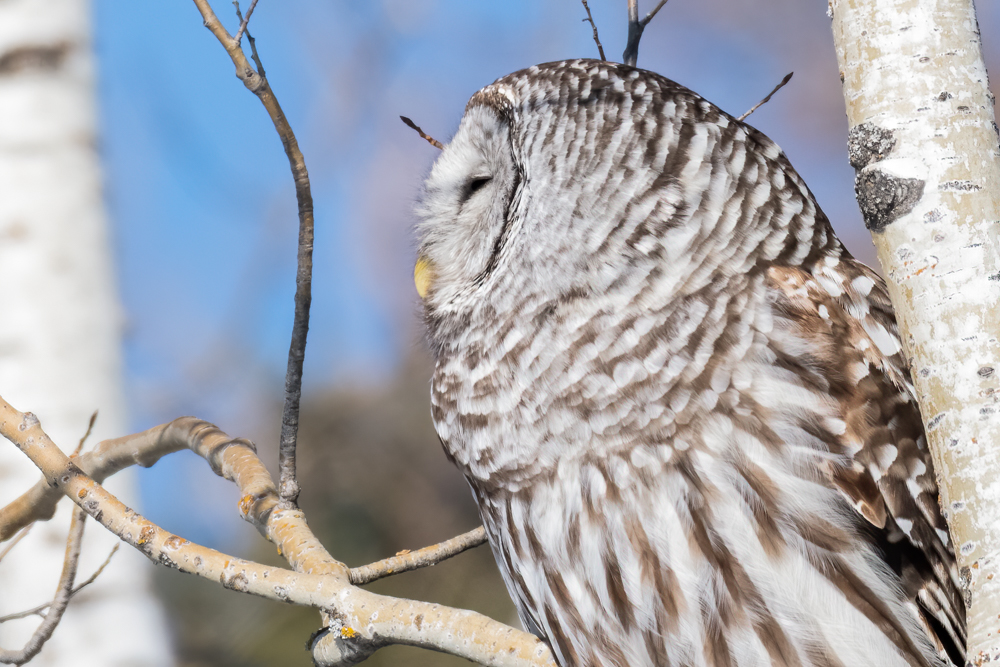
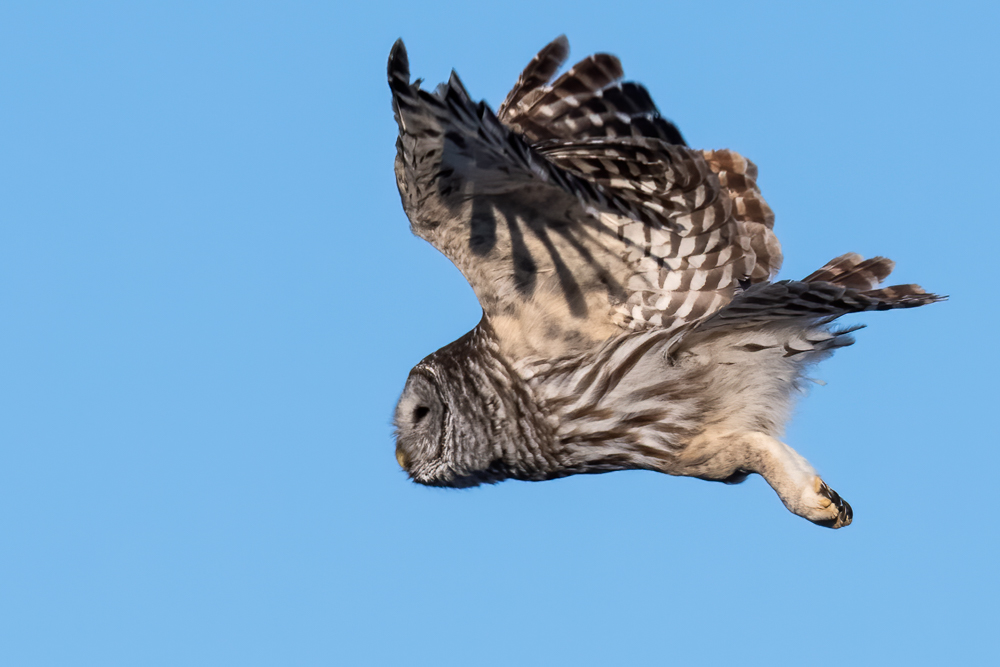
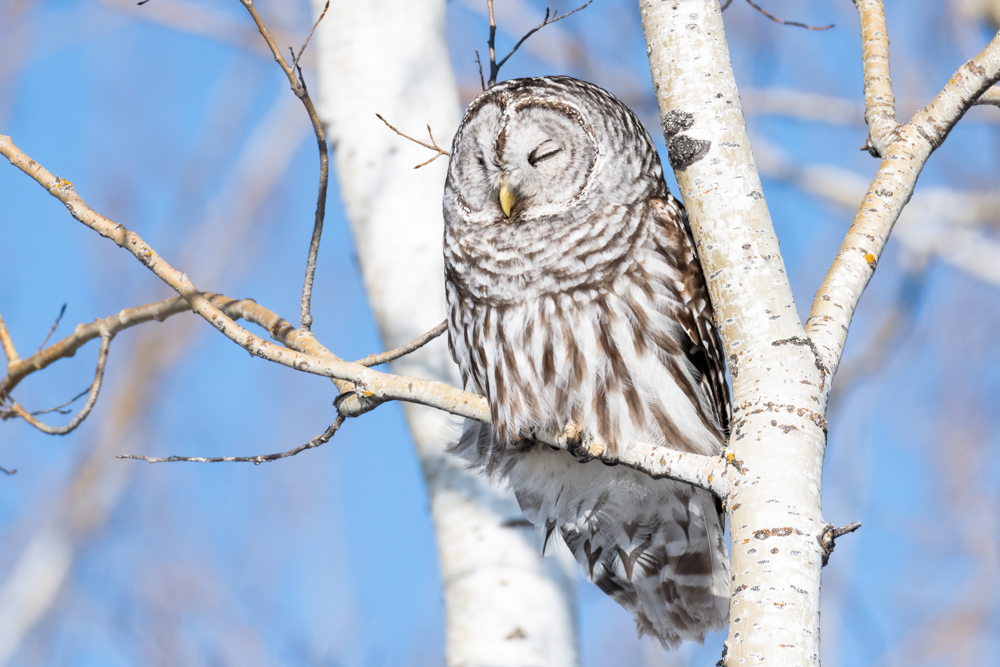
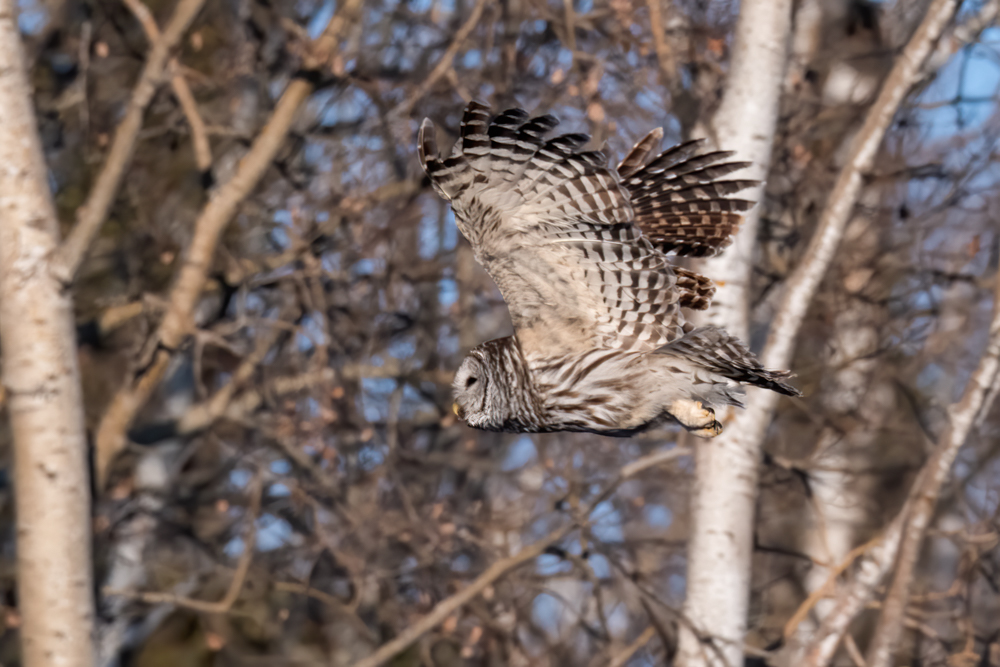
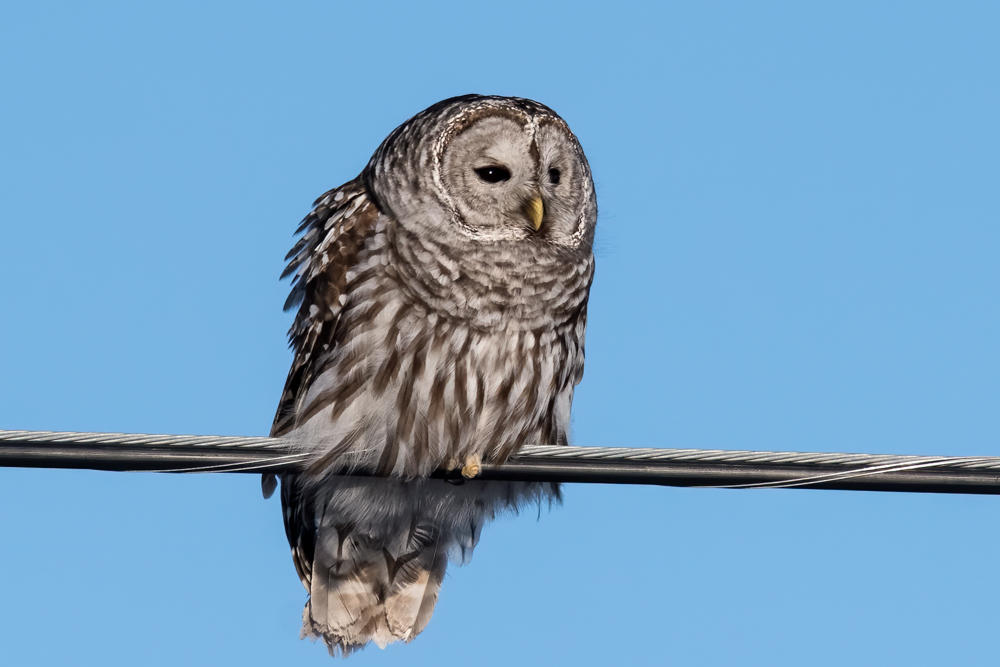
Upon returning with my sister in tow, I was overcome with a sinking feeling as I could not see our beautiful owl perched in his tree. The light had changed, and with it, so too had his ability to blend in. He had been quite camouflaged before the sun had begin to set, but in the dimming light, relocating him seemed impossible. We were all a little distraught as we scoured the area from top to bottom when a movement caught my eye. Off to the right of the aspen the hydro line sagged over a boggy clearing. And sitting all bright-eyed and bushy-tailed on the dip of the wire was our gorgeous friend, poised for the night’s hunt. What a relief. I pulled the vehicle ahead until I was directly in line with him and that is where we remained until day turned to night. In the interim, we were entertained by our friend as he caught his evening meal and I even managed a few pictures of this barred owl in flight.
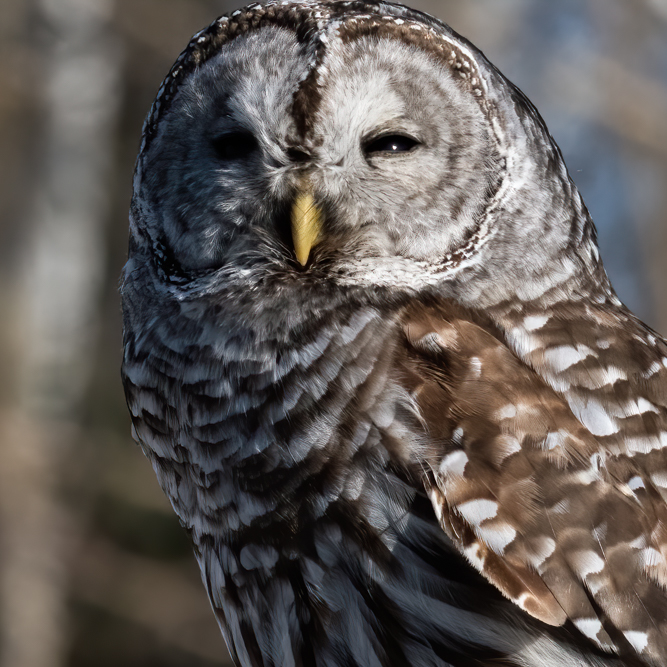
I am thankful for this winter’s birding season – not only because of the amazing encounters depicted above but also because I was able to enjoy these experiences with both Cindy and my sister, Marilyn. I cherish these memories now more than ever considering our current state of physical distancing. These outings have given me with a welcomed escape from the chaos and the wildlife therapy, as always, is good for the soul. As the calendar marches toward seeding and the spring migration, I am eager for the arrival of the snowbirds – like the blue heron, the ruddy duck and a wealth of raptors – and the mating rituals and the babies that follow. But I know that these adventures moving forward will be bittersweet as I will likely be flying solo – at least for the foreseeable future. Birding for me is more than just capturing photographs – it is a time to appreciate and connect with those who share my passion. In this new reality, the game has changed, and I already miss my friendly rivalry with Cindy. I guess until we can travel side by side once again, we will have to be content to compete in a social media arena. Hopefully by the fall migration, the world has healed, and it will be game on!
Covid Fallout
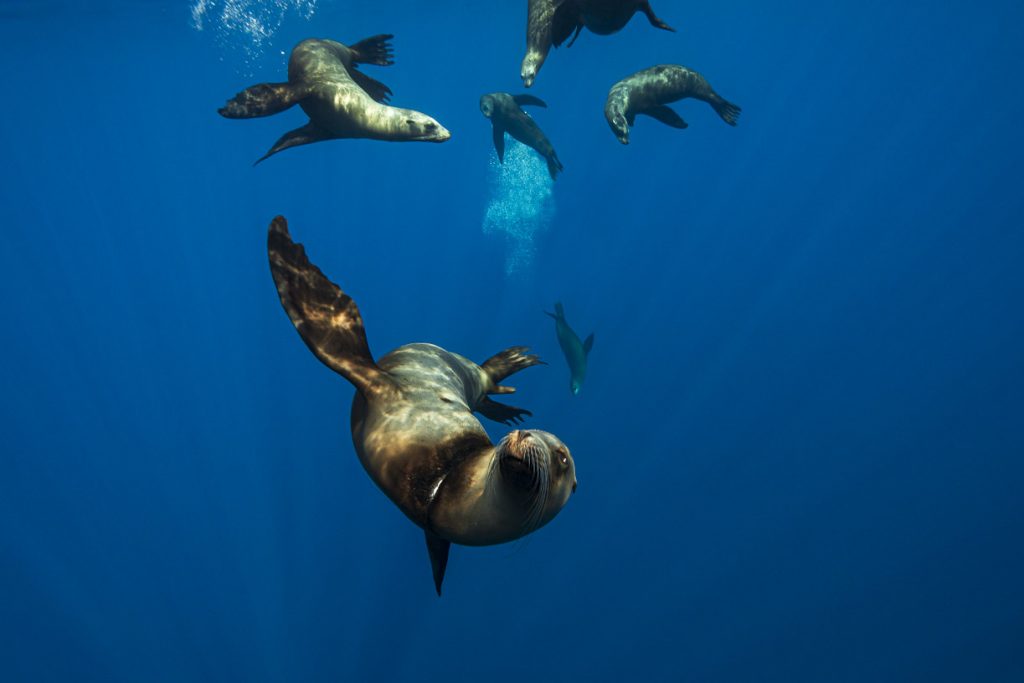
As we enter year two of the pandemic era, I have been reminiscing about my pre-Covid photography and how different my current experiences are and have been since Coronavirus first rolled off my tongue and I can’t help but long for that simpler time – unhindered by lockdowns and limitations. You could say that for a nature enthusiast such as myself, the chaos and closures brought about by this virus have had little impact on my ability to seek out wildlife or landscapes and capture images. If you simplify my passion into these two fundamental components, then yes, the former statement rings true. Even in our current code-red reality, you could argue that I am free to traverse Manitoba in hopes of encountering the sought-after subject of the week and the quality of the images I create is restricted only by my level of skill. But, for me, photography is much more than simply acquiring images from a day spent driving around. Photography is a powerful medium for effecting personal development, environmental appreciation and social change. And one of the key elements required for growth in all these areas is interaction with not just other photographers but with all people who have a vested interest in the subject at hand. And a meaningful connection doesn’t happen in a forum or Facebook group or online workshop – but in person. The shared experience becomes the catalyst for conversation that encompasses more than settings and gear to acquiring photographs that elicit emotions in the viewer – perhaps a sense of awe or wonder, or a desire to understand and learn, to a sense of responsibility for the protection of this amazing planet and the litany of life that calls it home. But with stay-at-home orders, restrictions on travel have had and will continue to have serious ramifications for our planet. Why? Well, to be honest, money is what drives real change in our world. Eco-tourism doesn’t just benefit the wannabe National Geographic photographers such as myself. It generates much needed revenue – and not just for tour operators, but boat owners, guides, hotels and their staffs, restaurants, those selling trinkets on the beach. This list is extensive. And if tourists are wanting to see shivers of sharks – then keeping those sharks alive becomes paramount to scoring some of those tourist dollars. And if tourists are wanting to see healthy creature laden rainforests, then preventing deforestation becomes important. And if tourists are wanting to snorkel a pristine reef…well – you get my point. But under our current pandemic situation, travel to many areas of the world just isn’t possible and as a result, I fear for what will happen to many of species whose lives depend on being worth more alive than dead.
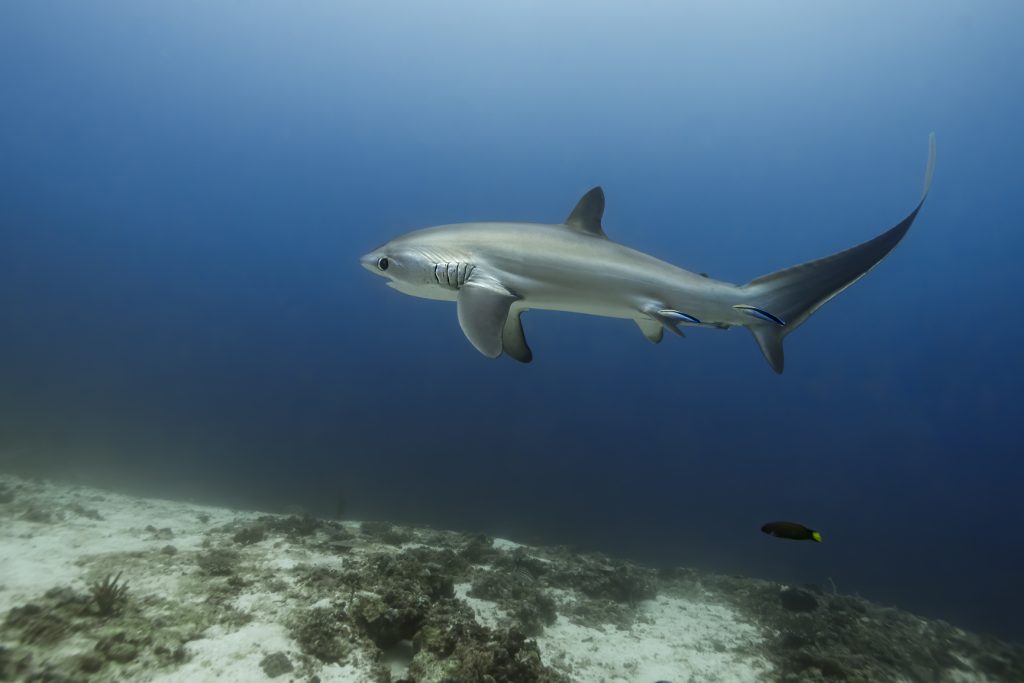
Last year at about this time, I was packing for a two-week Asian adventure beginning on the island of Malapascua in the Philippines. This remote area draws hundreds of divers yearly, each hoping to encounter the unique thresher shark (Alopias pelagicus). These impressive hunters prefer deep open ocean and spend most of their lives at a depth of 550 metres. But until maturity, these pelagics can be found in shallower waters – such as those of The Monad Shoal. This seamount cleaning station rises 250 metres from the sea floor in the Visayan Sea, and offers one of the best opportunities to see these big-eyed beauties. During our five days of diving, we encountered several juveniles enjoying inspection and parasitic-ridding by cleaner wrasse. Just as this symbiotic relationship benefits both the shark and the wrasse – ecotourism benefits the livelihoods of the the Philippine people and the survival of these ocean inhabitants. To be honest, my main reason for travelling to this isolated destination was to swim with these gorgeous creatures, study their behaviour, and capture images of them for my own shark collection. Yet each adventure reinforces my appreciation of nature and its diversity and by sharing my images of these creatures with family and friends and on social media, I hope that in some small way I can encourage others to value their existence. My connection to the underwater world has evolved and strengthened with each expedition and it saddens me to think about how this pandemic will impact its survival. Tourism to Malapascua Island keeps species alive and helps conserve their habitats. With closed borders and dwindling numbers of travelers, many of the dive masters we met last year have been unemployed. The sad reality is that if the sharks aren’t bringing in monies from tourism, the local people will revert to fishing and selling their catch to support their families. This short-term fix will have long-term consequences. When I took my first underwater images some twenty years ago, my goal was to document the existence of such beauty. Now it is to share this amazing world with a wider audience so that next time I roll off of a zodiac, with camera in hand, there is a breathing creature to photograph.
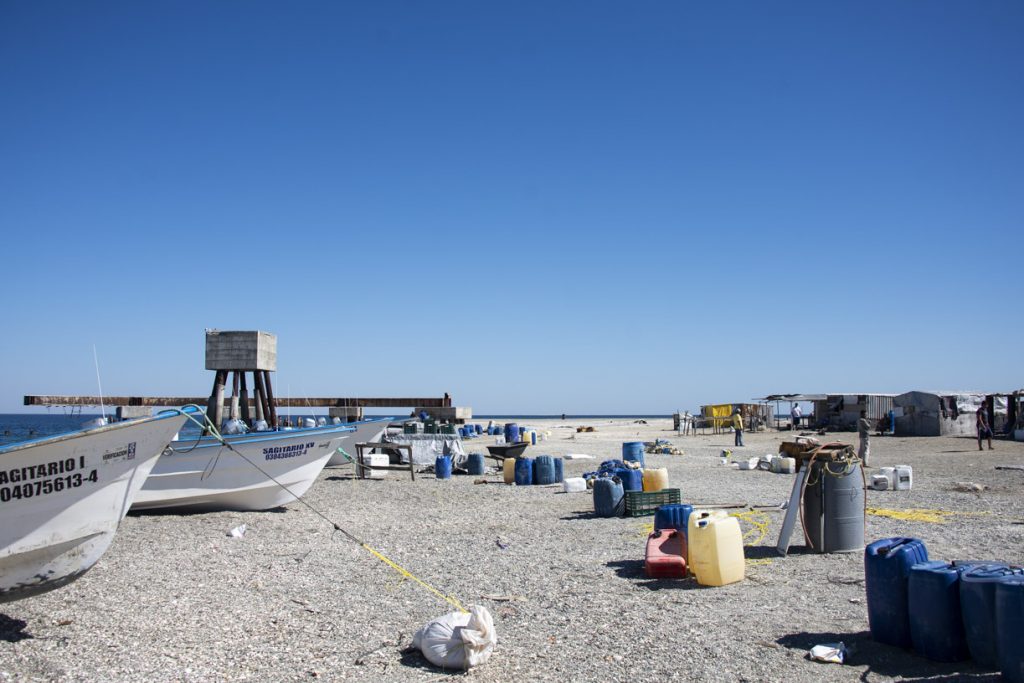
You might think that I am being a little melodramatic. But I have witnessed first-hand what happens to wildlife when they are worth more dead than alive. Take for instance this shark-finning camp located near Puerto San Carlos, Mexico. In an area of extreme poverty, the inhabitants use the resources they have to make ends meet. Unfortunately for the local sharks, they just happen to be a valuable commodity in other parts of the world where shark-fin soup is a delicacy . But, unlike the typical shark-fin fishery, nothing here is wasted. The people will sell the fins and the meat. And, to be clear, they are not getting rich off of this activity, but rather the people here are just making enough money to feed their own families. In their desperation, they are doing what they need to in order to survive. Yet, once the supply of sharks is exhausted, that source of income will disappear and with it, a vital part of the area’s ocean ecosystem. An entirely different scenario is possible if the sharks are worth more alive than dead.
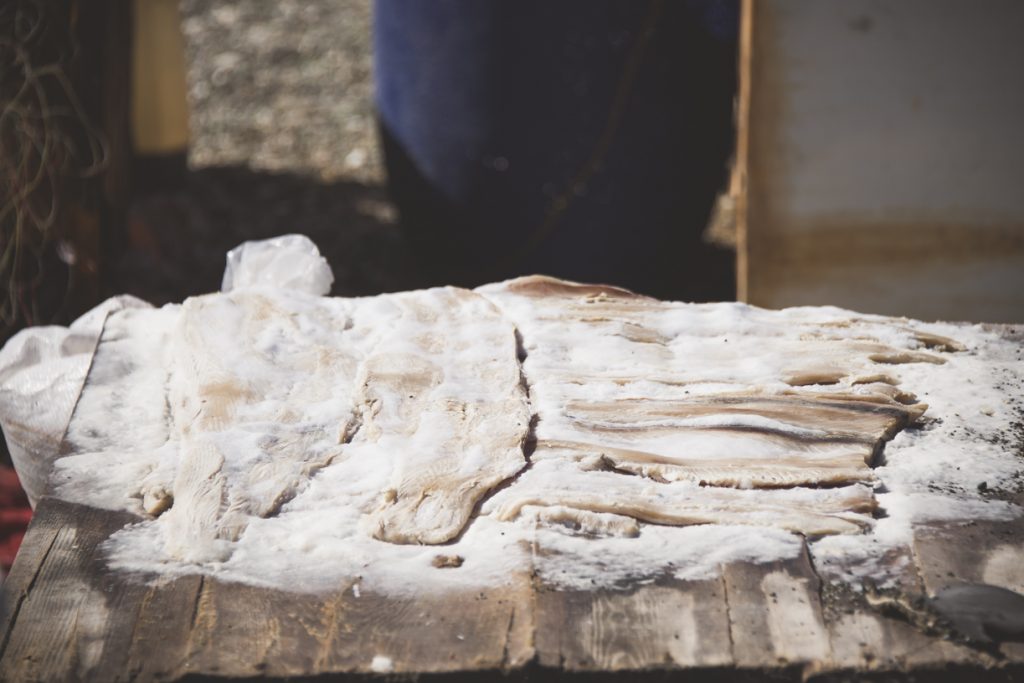
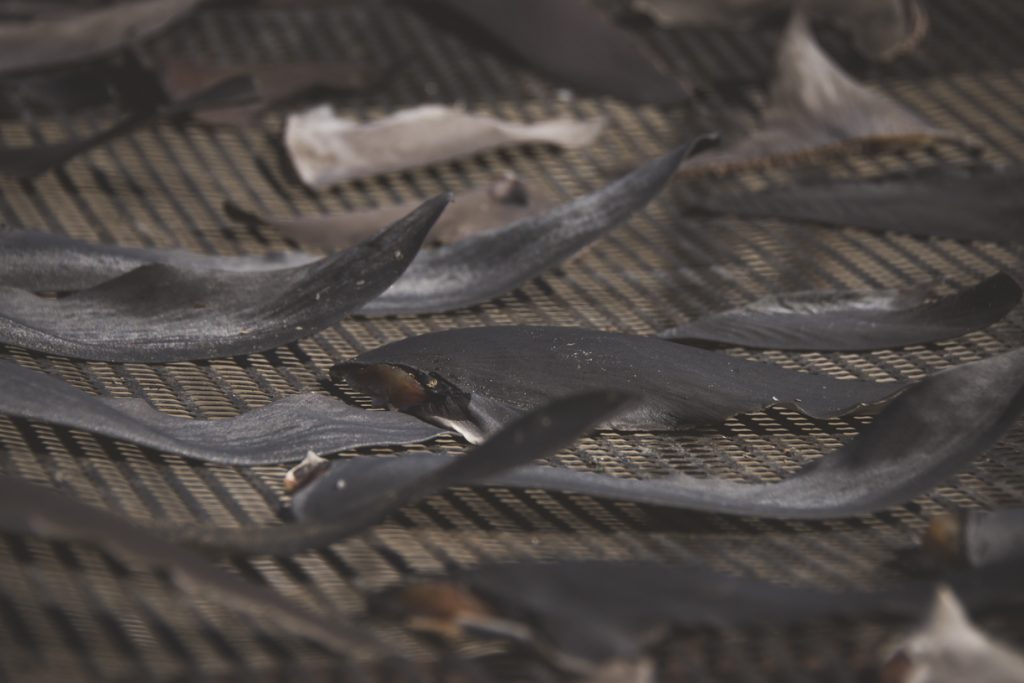
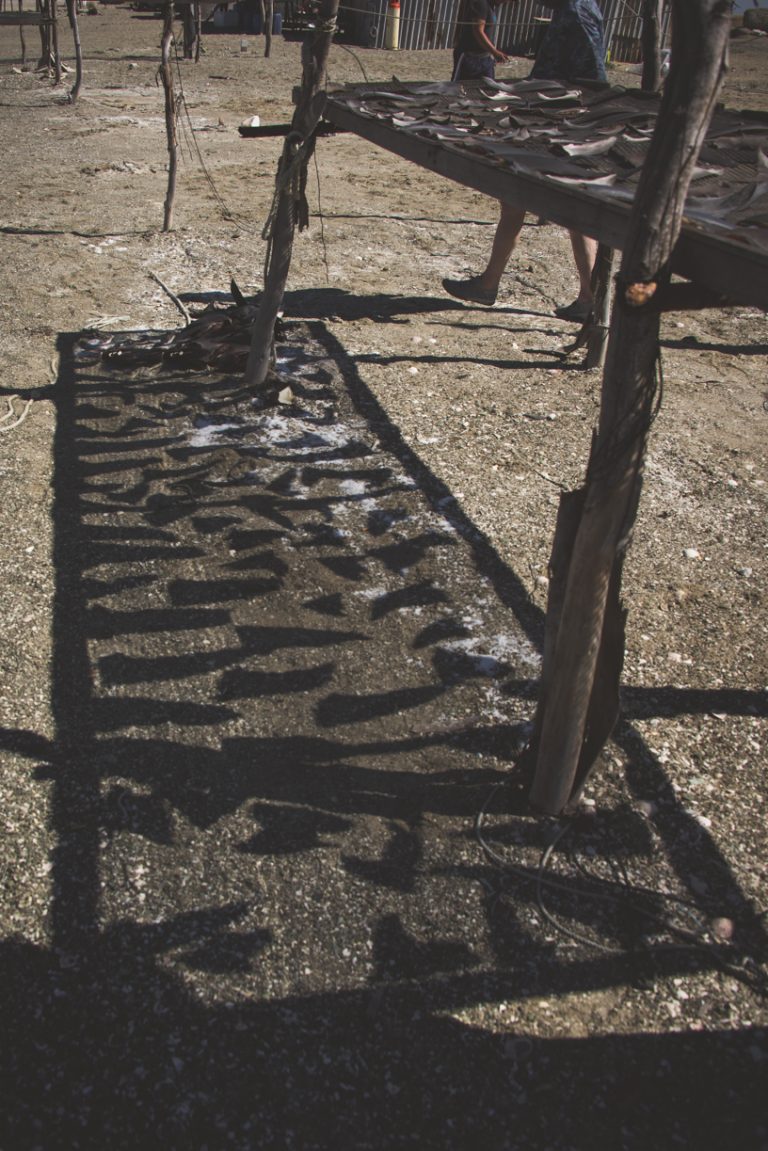
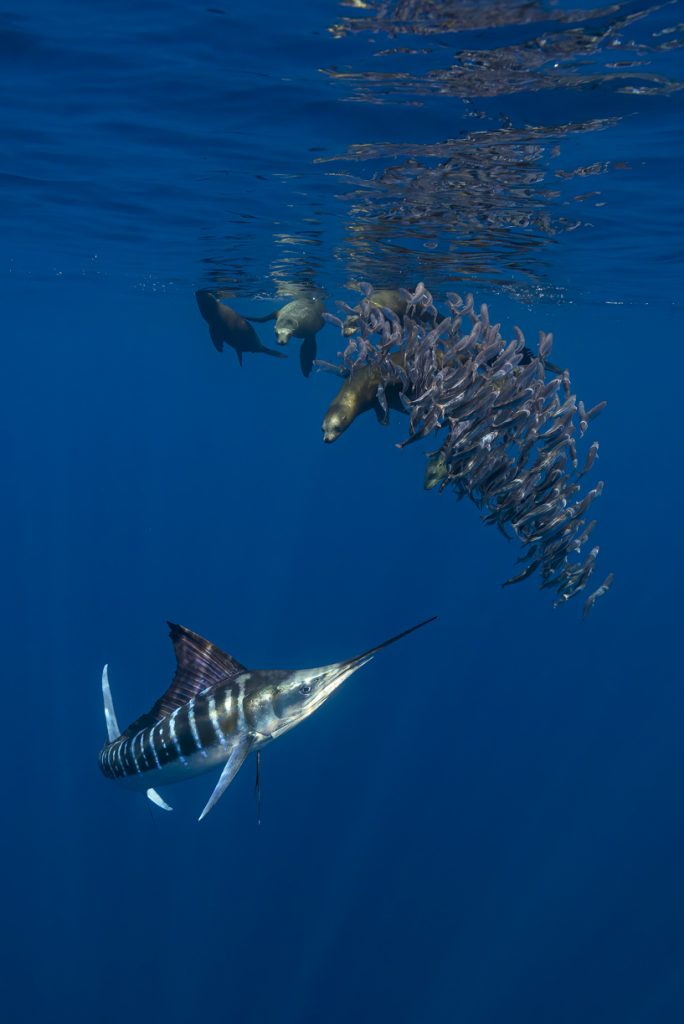
Each year, from mid-October to the end of November, an incredible phenomenon – known as the Mexican Sardine Run – occurs. During this six week period, sardine and mackerel migrate along the coast of Baja in large numbers forming impressive bait balls. The biggest aggregation takes place a couple of miles off of Bahia Magdalena, near the village of Puerto San Carlos. This epic event attracts tuna, marlin, sea lions, dolphins, sharks, whales and even orca. The migration brings in numerous sport fishermen all seeking the prized striped marlin as well as other trophy fish. The boat owners are hired to transport and guide groups of anglers. It is an incredible boost to the Mexican economy; however, over-fishing and trophy hunting are having a detrimental effect on fish numbers. But, with the introduction of eco-tours – tours that focus on the interaction between tourists and these ocean predators in a non-destruction way – the tour operators, boat owners, and guides are beginning to see value in protecting the marlin and other fish populations.
Back in 2018, we travelled to Puerto San Carlos with SDM for a week of snorkeling with striped marlin as they feasted on the bait balls. It was an incredible experience for so many reasons. For one – we got a front row seat to an amazing show. And – most importantly – we contributed to meaningful change. There are several eco-tour companies to choose from for these marlin expeditions – many bringing guests long distances each day for their encounters. Our captain and boat crew were from and lived in Puerto San Carlos. We stayed at the local hotel and ate all our meals at the local restaurant. We bought our beer at the one convenience store. Not all eco-tours are pumping money into the economies that need it most. But those that do are bringing about change in the way the locals value the ecosystems in their areas. And in this location, that means not only protecting what swims in the water but all animals and their habitats. We had a blow day during our trip – a day with too much wind to safely swim with marlin – so we toured the mangroves and photographed birds, walked through the sand dunes, and photographed the sea lions resting on the moorings and markers. The benefit of keeping all creatures and their habits healthy is undeniable. Or at least it was. I have no data on the change in tourism to this area of Mexico since the virus became a reality about a year ago but I can speculate that they – like many others – are facing economic hardships from the changes and restrictions to the travel industry.
In this new reality, I feel helpless. I miss travelling for so many selfish reasons. I want to find jaguars in the Pantanal. I want to photograph elephant seals as they hunt. I want to snorkel with belugas. I want this pandemic to end and some sort of normal to return. So much of what is happening in the world today is out of my control. I can only hope that this year brings with it a lifting of closures and return to pre-Covid travel opportunities. So much depends upon it – Lives and livelihoods of not only people but all life and their ecosystems too.
